Disclaimer: This post contains affiliate links to handpicked partners, including tours, gear and booking sites. If you click through or buy something via one of them, I may receive a small commission. This is at no extra cost to you and allows this site to keep running.
Visiting Hebron in the West Bank in Palestine and understanding the divided city on a Dual Narrative tour with Jewish and Arab guides.
Visiting Hebron in the West Bank is as much about the importance of making your own informed decisions as it is about travelling to Palestine.
An essential part of understanding the difficult and troubling perspective that exists as part of the Israel Palestine conflict, travel to Hebron is a chance to hear the story from both the Jewish and Arab perspective on a ‘Dual Narrative’ tour. First-hand information is key to making your own informed decisions – not just about Hebron, but the region as a whole.
“Hebron is a microcosm of the Holy Land issue overall. There are just different narratives of the same holy place – Jewish and Palestinian narrative of the Holy Land being the biggest riddle in the entire world.”
That’s what Eliyahu, our Jewish tour guide, said as we travelled to Hebron – the most heavily contested area of the West Bank in Palestine, also referred to as the Palestinian Territories.
It was an absolute given that I would be visiting the West Bank during my travels in Israel. Personally, it was a priority for me when travelling here, to understand what is going on outside of the particular bias reporting of our own country’s media and away from the strong perspectives of our peers, which can easily sway us.
Yet also, it’s important to realise that BOTH the Jews and the Arabs have their own stories to tell.
The Israeli-Palestinian conflict, the divide, the extremist governments and leaders on both sides – it’s neither an easy discussion nor a tit-for-tat situation, as some people express. When tensions flair, discussion turn to the misuse of the word conflict – when the fight on either side isn’t fair and equal. Neither is the average traveller a conflict resolution expert. Not all Jewish people and Israelis are reflective of their extreme government, just how not all Palestinians are reflective of the extremist factions that claim to support their cause.
I do not support the construction of Jewish settlements or the heavy military occupation under the current government. But I can support Israelis who want peace and an end to this. When there, it’s not hard to see how Palestinians are encroached upon in a land that was once free and shared by all as peaceful neighbours, but which is now occupied with force.
Ignoring that as a visitor is to ignore the reality of this country. Israel and Palestine history narratives are extremely complex. But that doesn’t mean that I, and you, can’t gain an educated, well-rounded and balanced perspective on it.
Because what I do know is that there’s actually an amazing group of Israeli and Palestinian people working together for the greater good. Especially in Hebron.
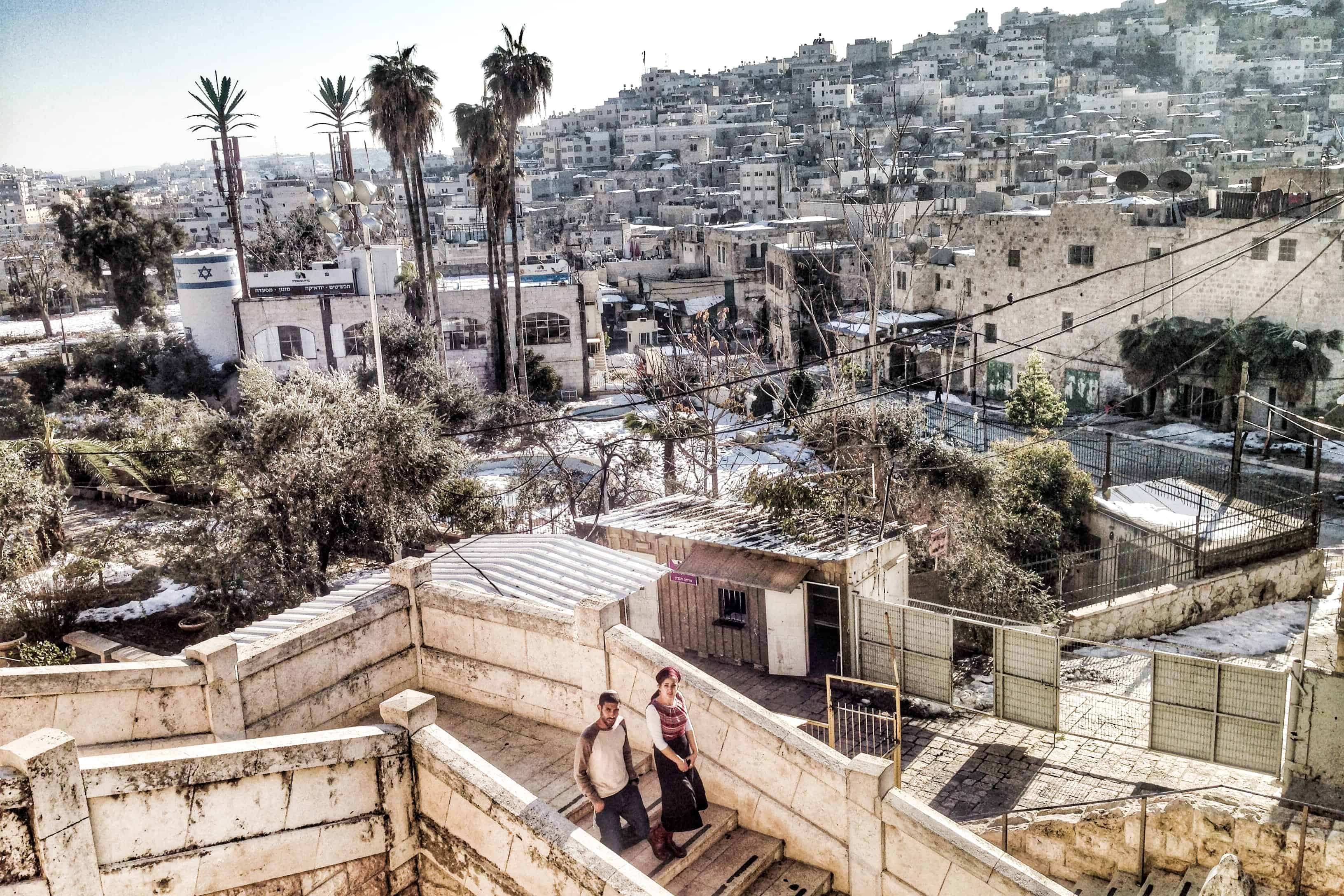
Visiting Hebron in the West Bank – The Divided City of Palestine
Contents
Why Visit Hebron in the West Bank?
Embarking on a trip to Hebron might sound extreme. Still, a chance to see the West Bank in Palestine teaches you one important lesson that you should carry with you through your days of travelling in this region – that the actions of extremists on both sides are in no way reflective of the people in both countries who go about their day-to-day lives while all this is going on.
A Hebron tourist can, therefore, be said to help bring about the greater good in understanding rather than be put in the same bracket as negative voyeurism.
So next time you call out Israelis for being bullying, gun-touting land-grabbers and Palestinians for being fanatical suicide bombers, remember that there are normal people on the ground who have nothing to do with the wider agendas of their governments or religious factions but who see each other as neighbours and who are calling for the same thing – resolution and peace.
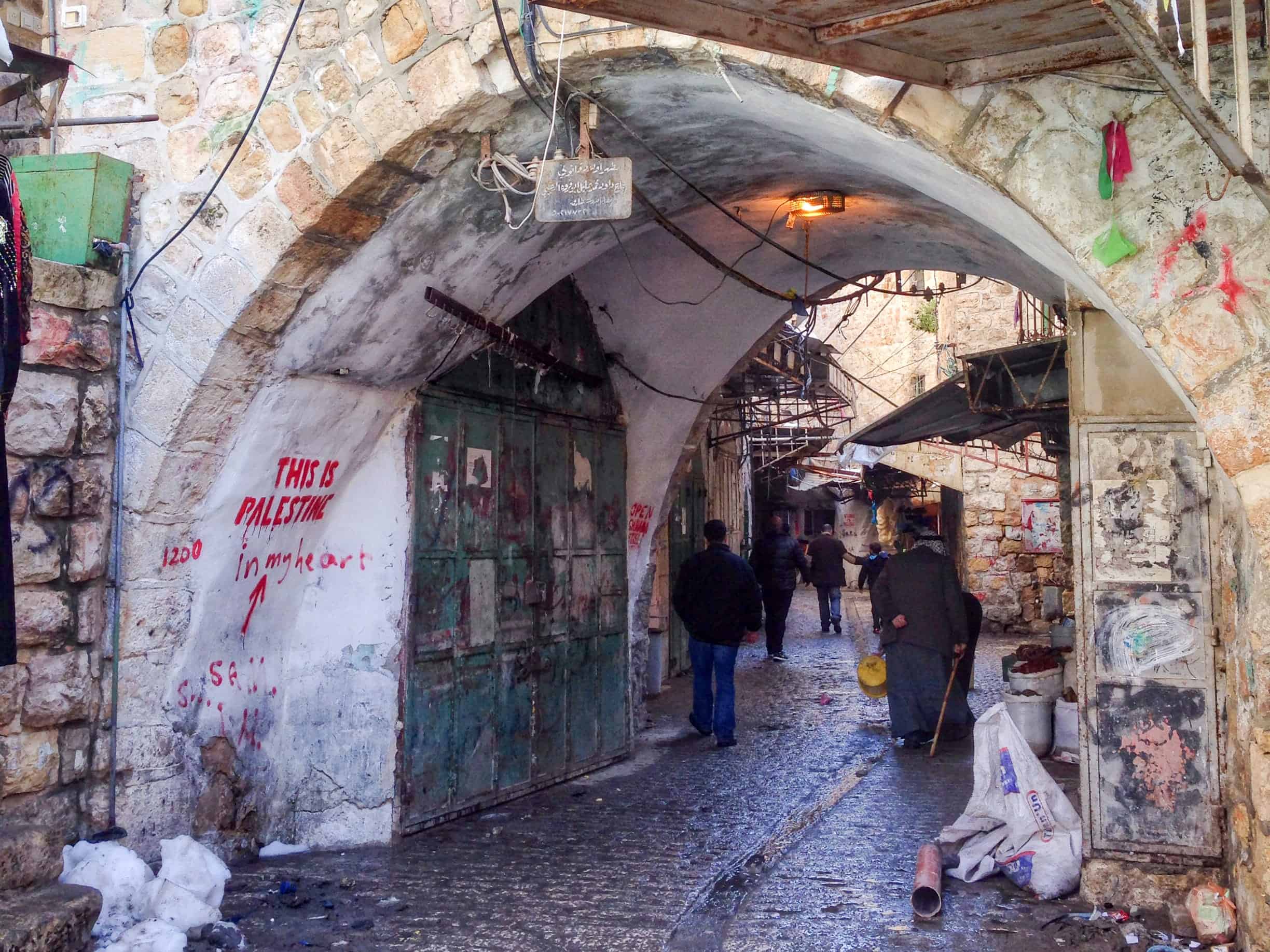
The city of Hebron is at the centre of a divided and troubled Palestine
Where is Hebron?
The divided city of Hebron is the largest Palestinian city after Gaza and is said to be where the settlement movement started – a major issue in today’s ongoing conflict. The meaning of Hebron comes from the Hebrew verb ‘to join’, ironically at odds with its current position where people will always debate if it is Hebron in Israel or Hebron in Palestine. Much of the contested part of its meaning as a Hebrew city comes from Abraham settling there for many years.
Palestine History, the History of Hebron, and the West Bank Conflict in Brief
Home to over 750,000 Palestinians and around 850 Jewish Settlers, Hebron is split into two areas. Following the Oslo Agreement Hebron Agreement in 1993, which saw the withdrawal of Israeli forces in parts of the West Bank and the establishment of the Palestinian Authority who would control Palestinian cities in the area, Hebron was an exception and given its own terms of the agreement.
Considered the second holiest city after Jerusalem for the Jews, it’s also one of the four holiest cities of Islam (after Mecca, Medina and Jerusalem) and hence control of this part of the West Bank is more complicated.
Here, the Palestinians authorities control H1 (80% of the population). H2 (20%) is controlled by Israel – nearly 750 Palestinians live here alongside approximately 850 Jewish settlers and 2,200 Israeli soldiers. Over time the Palestinian population in H2 slowly decreased following rule, curfews, restrictions on movement, the closure of Palestinian businesses and commercial outlets and settler harassment. The Jewish ‘settlers’ are a separate component to the puzzle, governed by their own administration and with their own agenda, but essentially Israeli forces protect them.
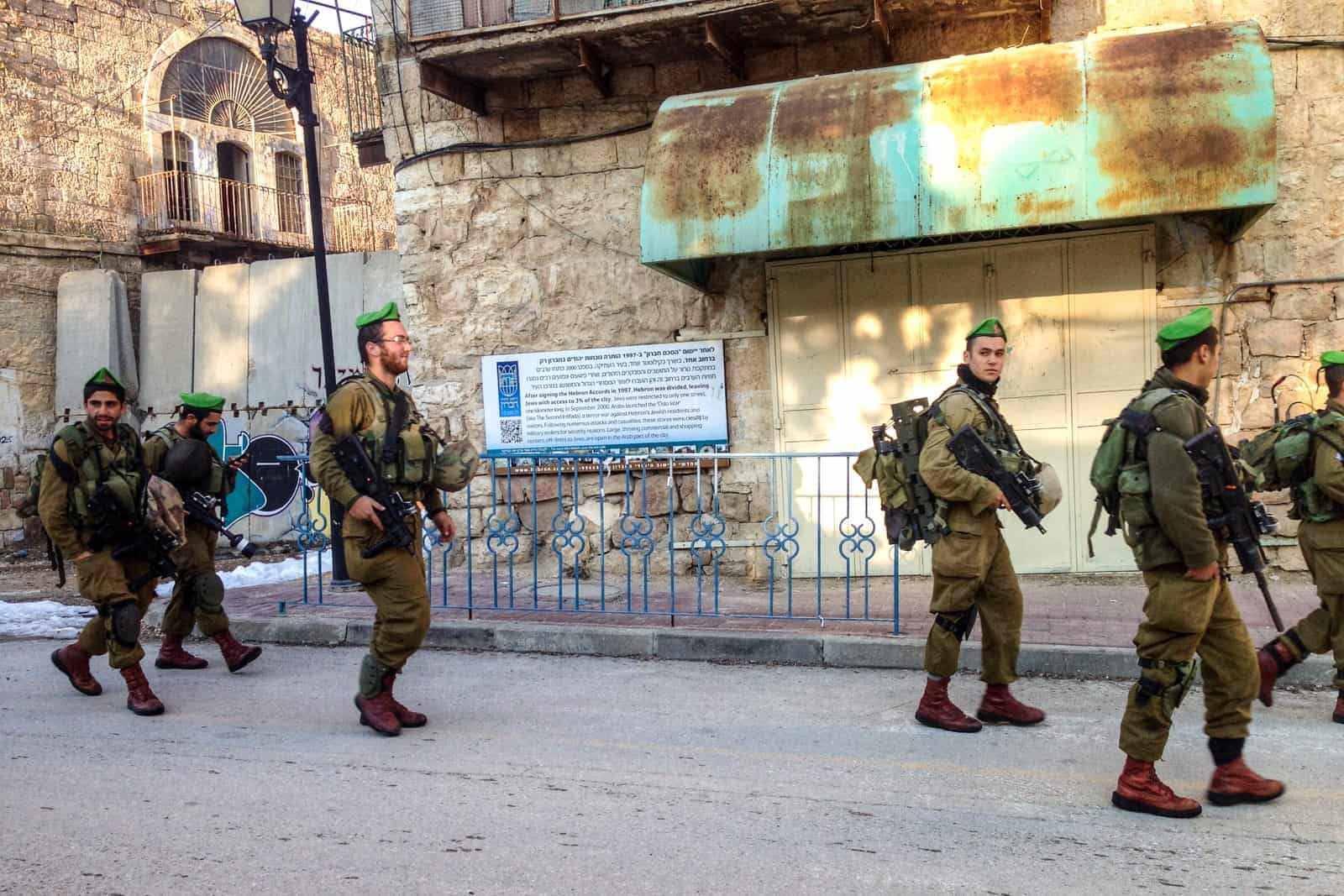
Israeli army soldiers on the streets of Hebron
How Can You Visit Hebron Responsibly?
While you can take a West Bank tour safely and easily, visiting the key cities of Bethlehem, Jericho and Ramallah, this story is specifically about Hebron.
I joined a ‘Dual’ Narrative tour in Hebron, a joint partnership of the Israeli-owned Abraham Tours and the Palestinian Visit Hebron-Palestine initiative, where half of the day would be spent with a Palestinian guide and the other half with a Jewish guide. Travelling from Jerusalem to Hebron and back again is an emotionally compounding day you won’t forget.
Visiting Hebron from the Arab Perspective
Our Jewish guide, Eliyahu, chaperoned us from Jerusalem to Hebron, which is easy enough to get to from Jerusalem’s central bus station via a public, bullet-proof bus, where we were given a brief overview of the history and present-day situation. On arrival, we immediately met our Palestinian guides, leaving Eliyahu behind for a few hours while we were to go to H1 (he, being Israeli and unable to enter).
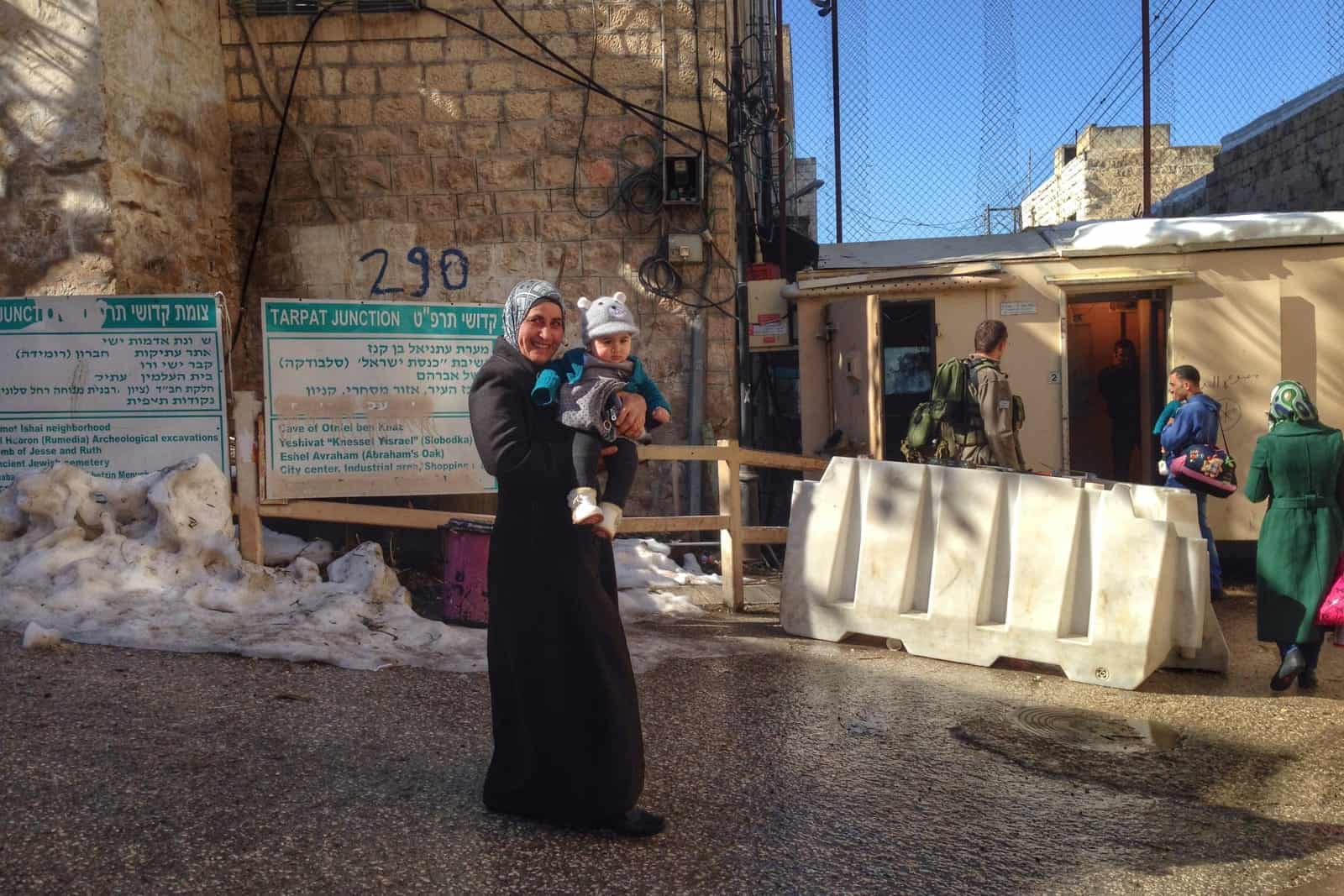
Israeli checkpoint in Hebron, where you can cross between the H1 to H2 sides
Entering Hebron – H1 West Bank
We met our two Palestinian guides, Mohammad and Leena, on what is called ‘Apartheid Street’ (Shuhada Street) – given that name by Palestinians since they are barred from using it and being seen as a space of protection by the Israelis.
Once a thriving shopping lane, and now an eerie empty space, you feel the atmosphere here as you wander slowly past the closed shops towards the simple yet daunting checkpoint at the end, guarded by the heavily armed Israeli military. It made the seriousness of the situation all the more real.
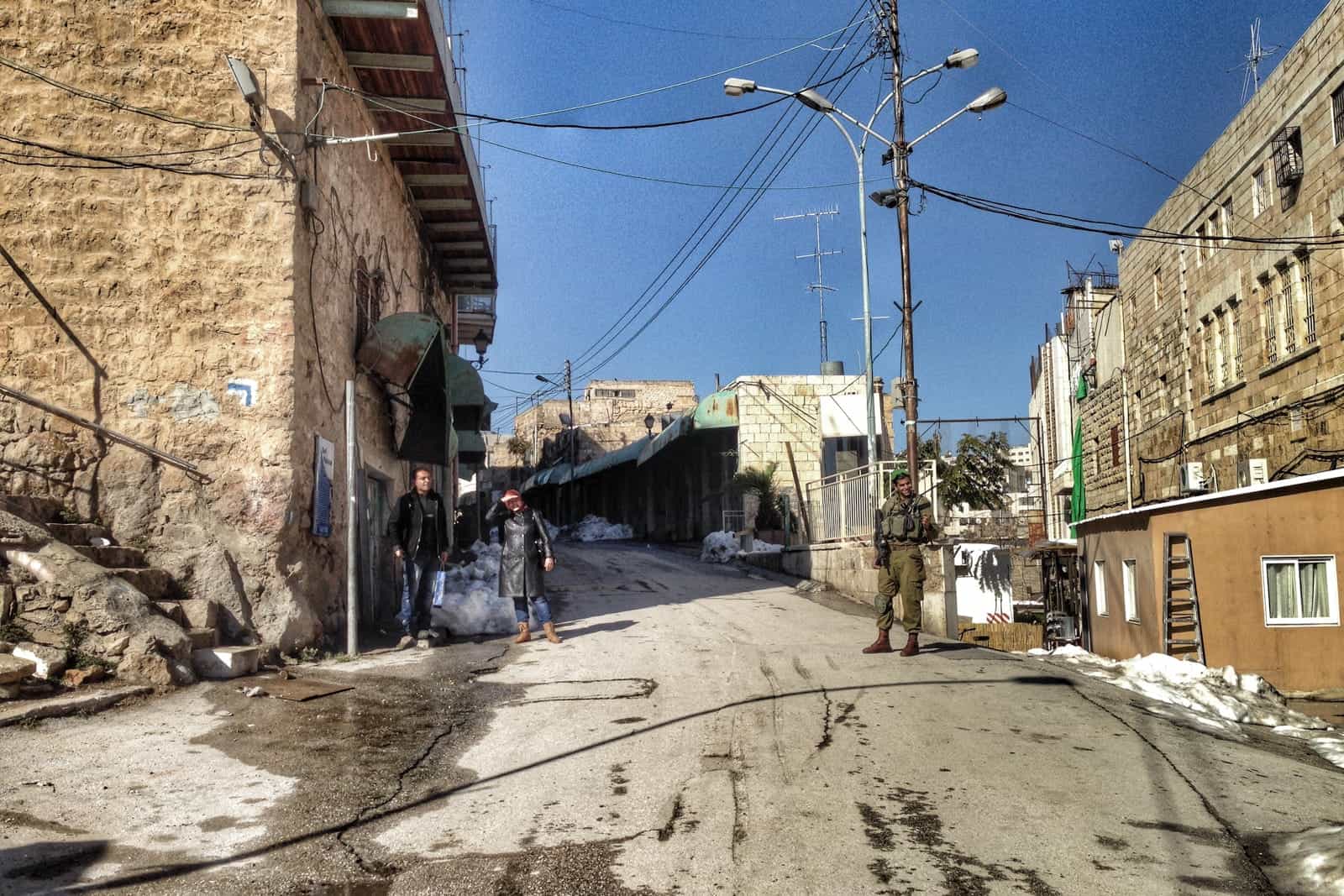
Entering the Arab side of Hebron on ‘Apartheid Street’ (Shuhada Street) on the Dual Narrative tour
Crossing through, we entered another world – a chaotic old city full of cars, bikes, food carts, and throngs of people. We were told it was once a ghost town, but then the Palestinian government implemented initiatives to encourage people to return to this old part of the city.
We meandered the bazaars and spoke to locals, many having closed their businesses and others desperately holding onto those their fathers and grandfathers had once set up.
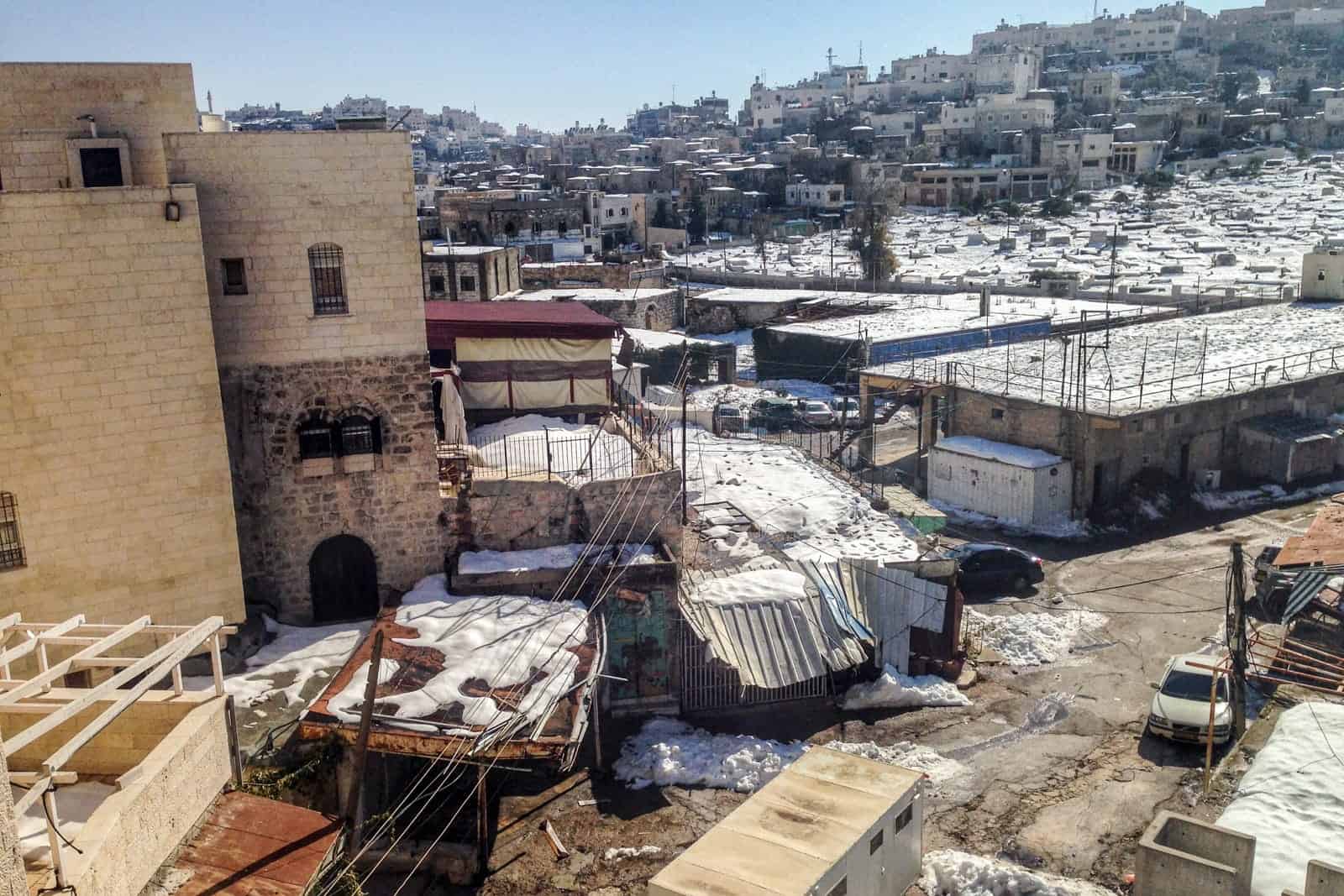
Overlooking the divided city of Hebron in the West Bank
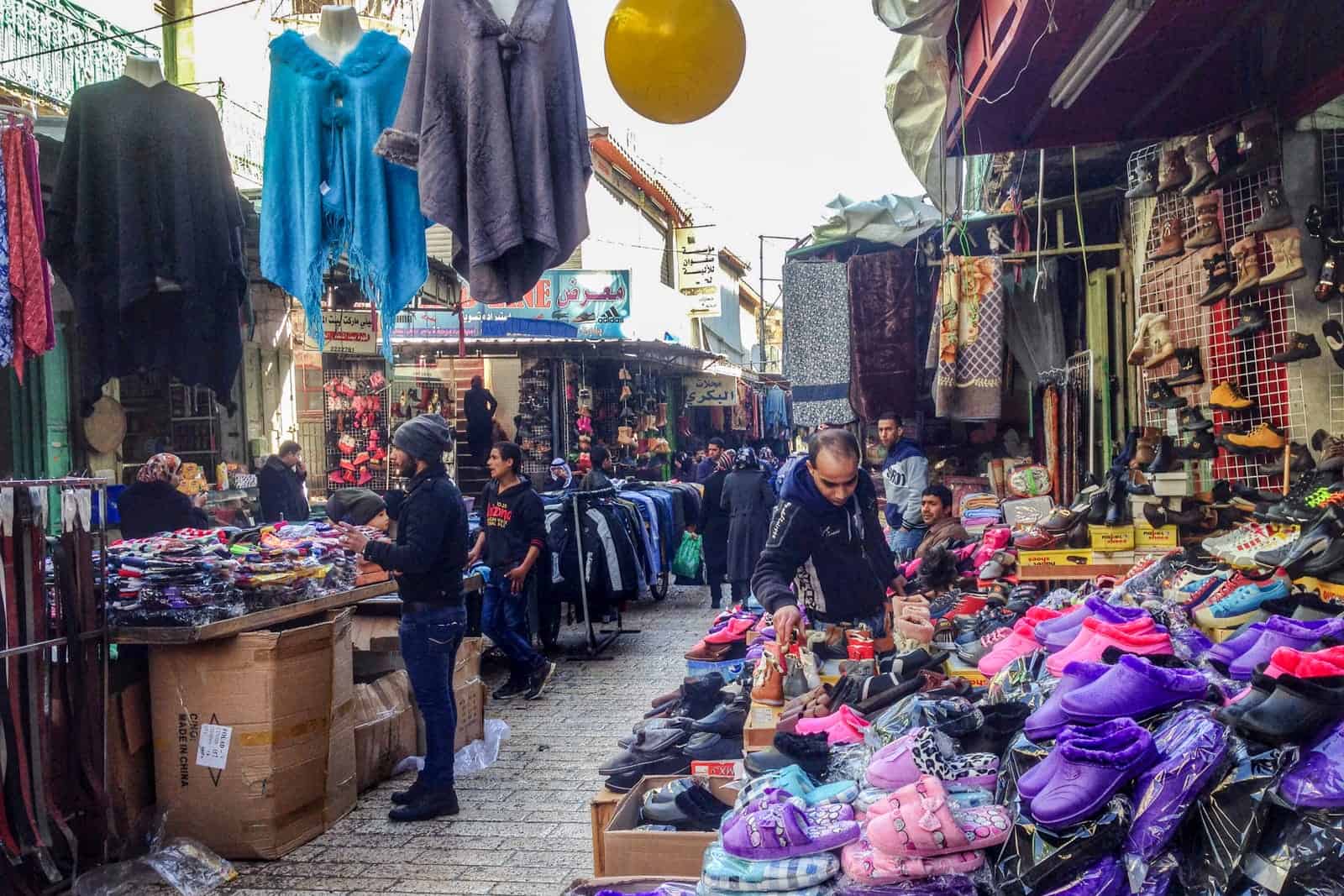
Life in Hebron
I never once felt unsafe here, and nor do the Palestinian people make you feel unwelcome. In fact, many treasure the opportunity to share their stories, knowing that you will share them. But there’s no denying that you could feel the tension, and then we worked out why.
We looked up and saw modern stone buildings standing high above the old crumbling marketplace inhabited by Jewish settlers, the walls literally touching that of the old city.
The thoroughfare of the bazaar was covered in a roof of wire mesh, that had collected stones and plastic bottles like a giant sieve, items that the settlers are said to have thrown below, including urine and bleach (the other side of the narrative is that the Palestinians were also throwing items at the settlers).
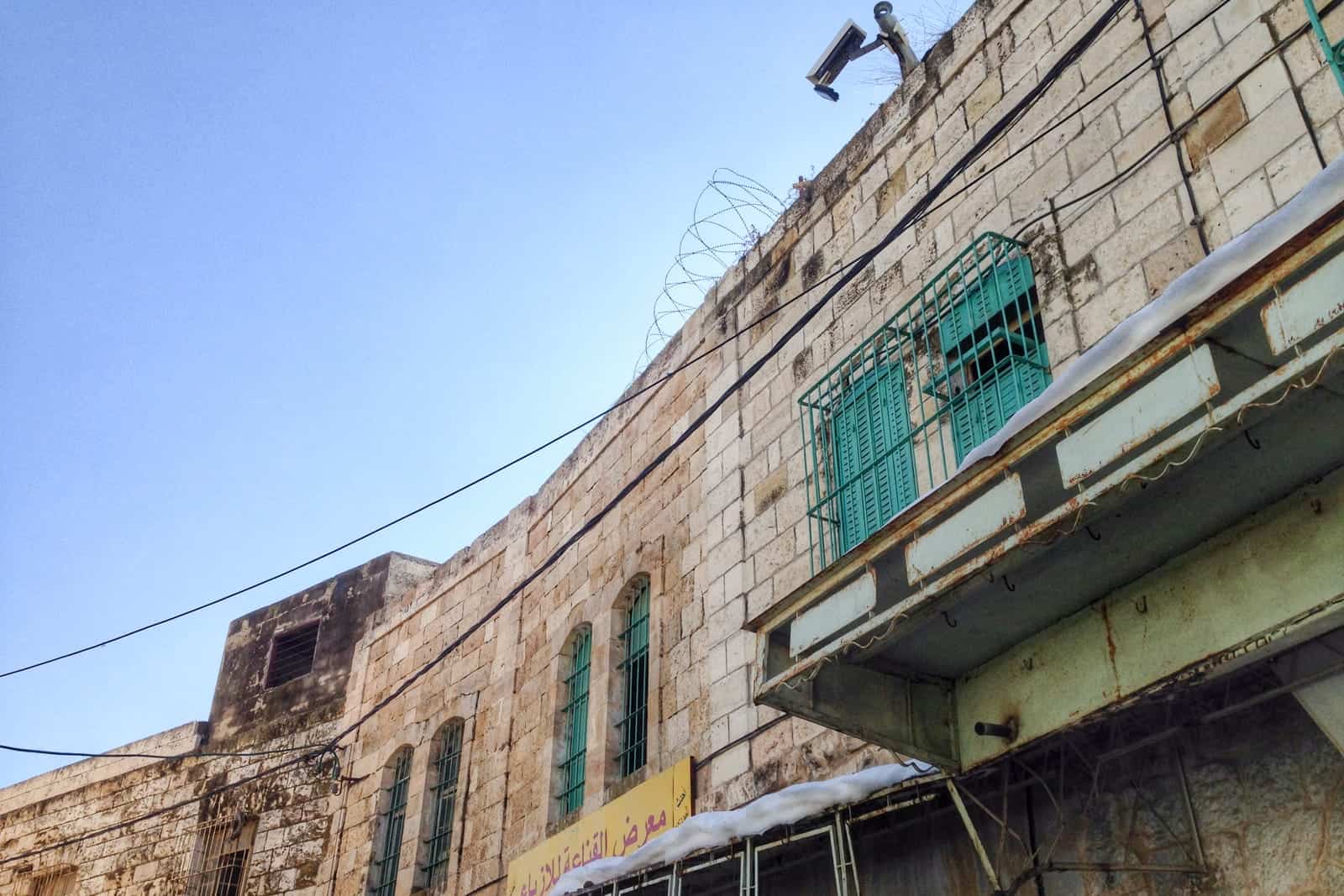
Security cameras from Jewish settlements overlooking Arab side of Hebron
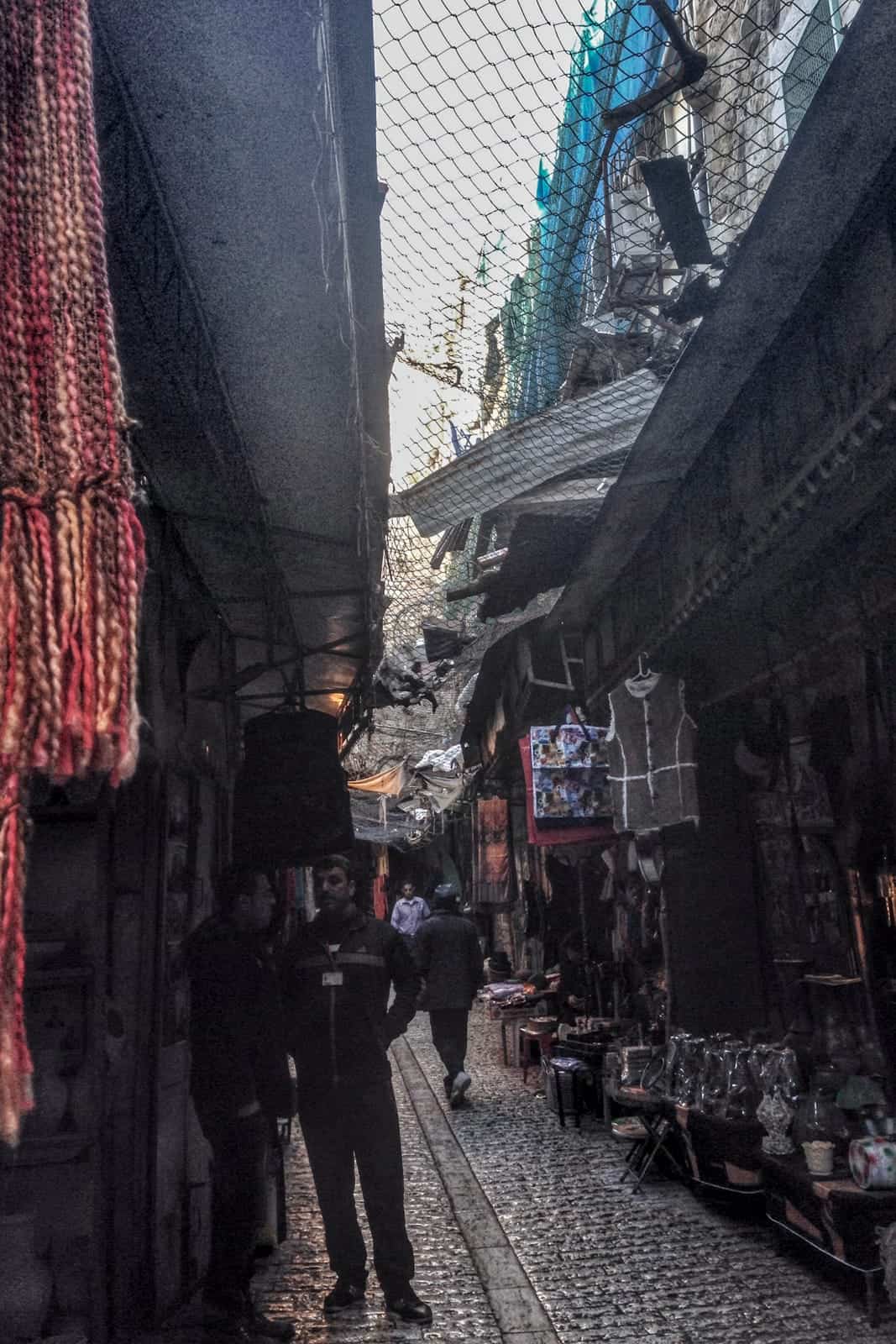
The wire mesh covering the roof of a market in the Arab side of Hebron
We looked around abandoned alleyways and noticed the end of old passages boarded up with sheets of steel, stone, plastic and whatever else could be used to block the entrance… to land now occupied by Jewish settlers.
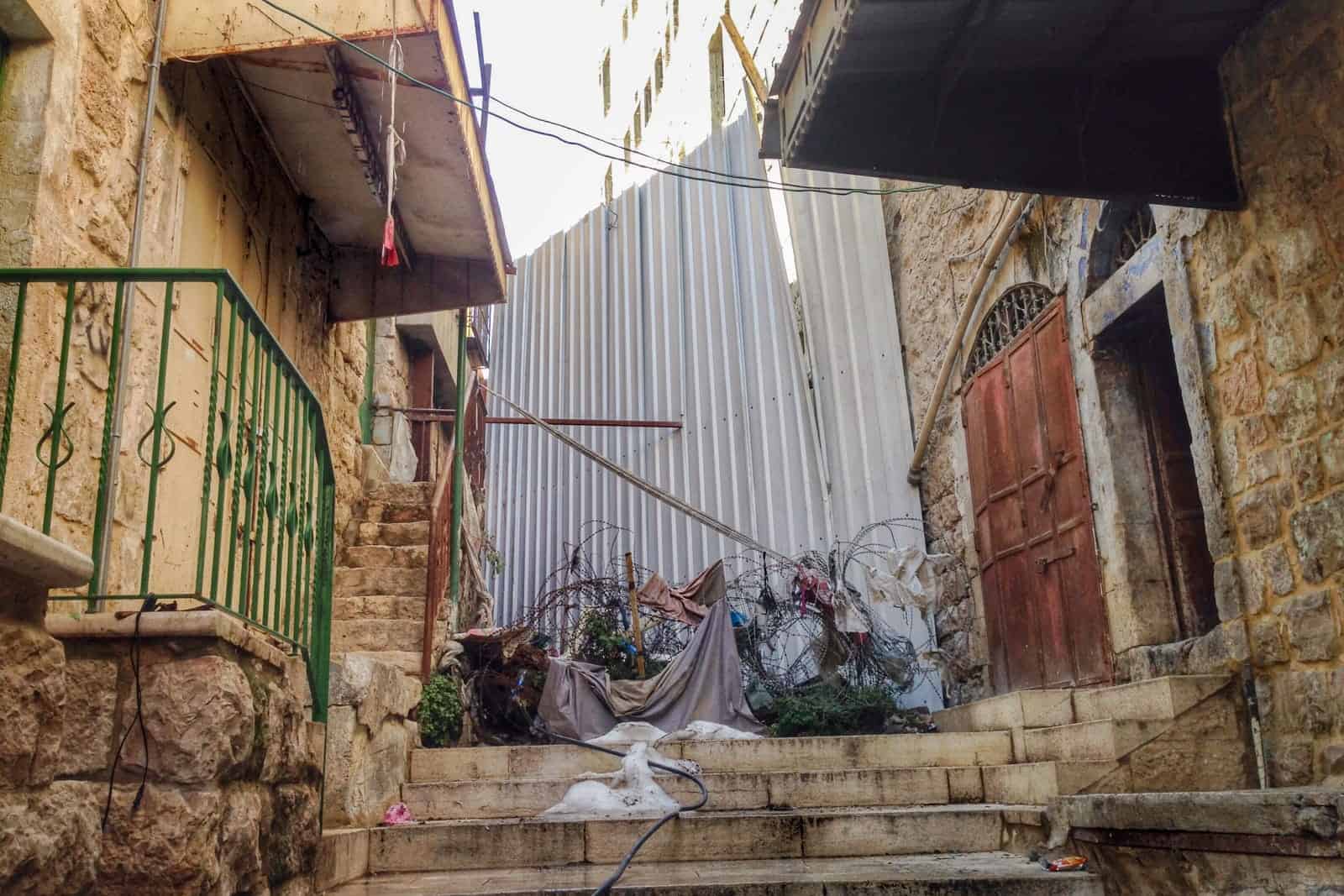
Man-made barriers dividing the two sides of Hebron
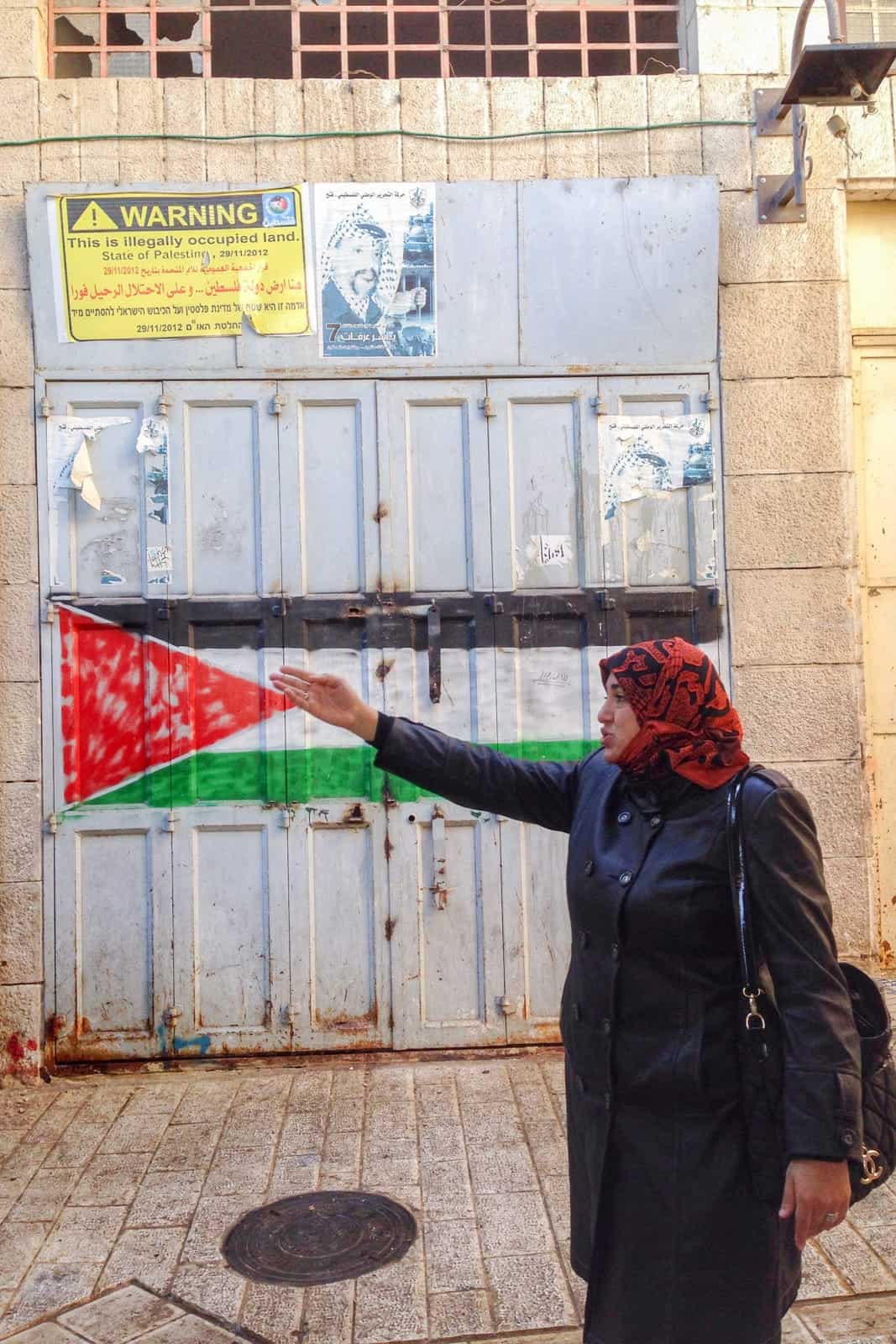
Palestinian guide on dual narrative tour of Hebron in the West Bank, Palestine
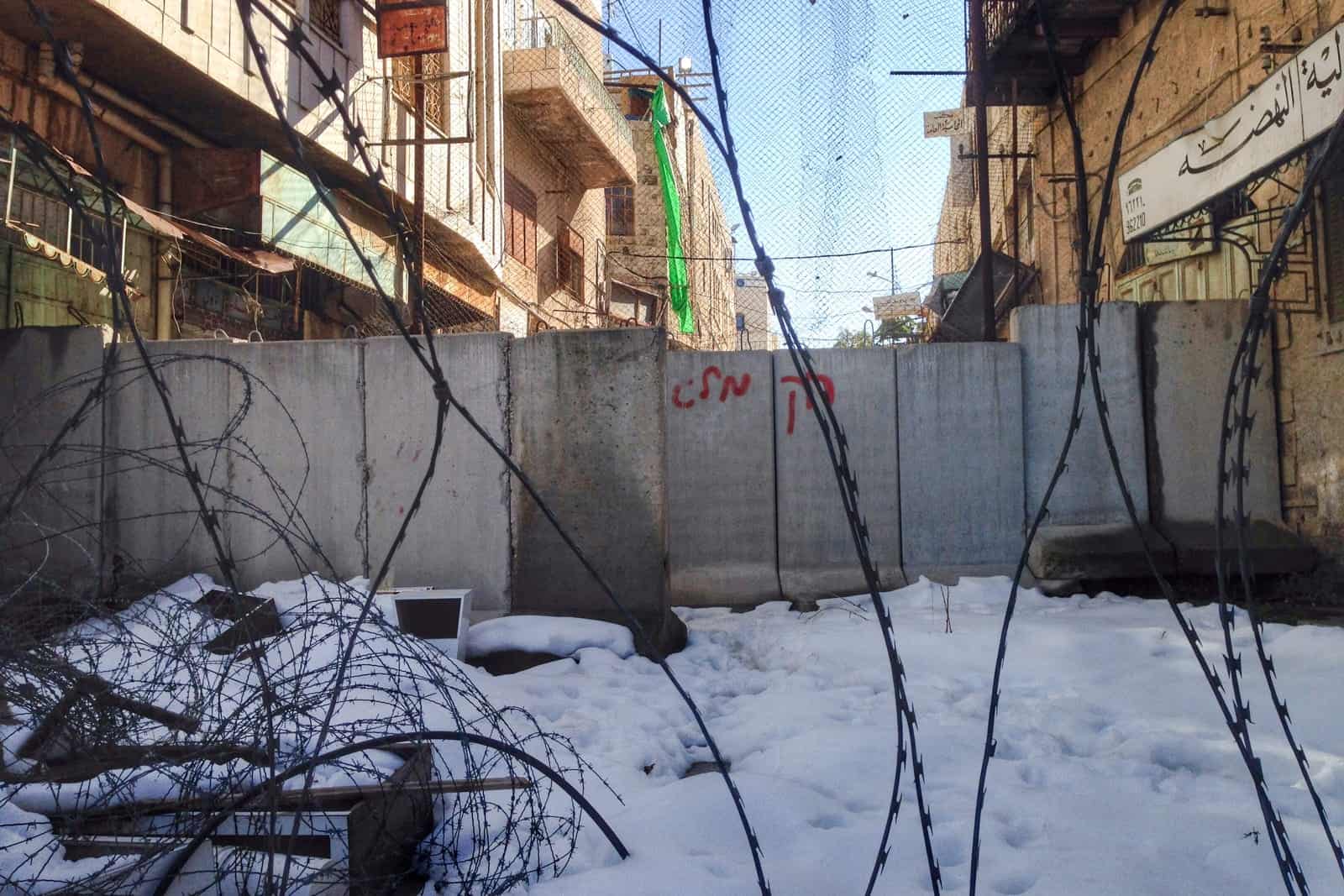
Walls and barbed wire fences separating the Jewish and Arab areas of Hebron in the West Bank
We walked through houses and stairwells to reach the rooftops of local Palestinian properties to find Israeli checkpoints all around us, where armed soldiers took guard on rooftops and hillsides. We were told that Palestinian people are not allowed to lock their doors and that Israeli soldiers could come in at any time. Those houses are taken by force since many Palestinians refuse to sell their properties for the millions of dollars offered by the settlers.
Essentially, they are watched and controlled here at all times, not only with checkpoints but with 100 or more cameras – supervision in H1, which shouldn’t have any Israeli control at all.
Some of the group cried, and some sat in silence, full of anger, after we had entered the mosque side of the Tomb of the Patriarchs (a place divided in two after a massacre in 1994 that saw a Jewish man open fire on Muslims on Ramadan) and watched Israeli military act disrespectfully. Walking around with their shoes on and the women not covering their heads, many made smirking gestures, and one even curtly told our Palestinian guide to leave the room we were in.
These were not like the Israeli soldiers we had seen elsewhere, and watching Leena break her heart over the whole situation proved that a whole different level of control and attitude exists here, unlike anywhere else. I can only imagine how being posted in Hebron could send you crazy or make you devoid of all rational thought and feeling. However, this is no excuse for the overarching agenda of the system deploying them here.
Our time in H1 ended with having lunch with a Palestinian family, although by this point, we were not in the highest of spirits. All we could do was watch the happiness of the children playing, hoping that one day things wouldn’t be so bad for them – they are the next generation who can make a change.
We bid a sad farewell to our guides, feeling as if we had known them longer than just a few hours we spent with them and grateful that the insight here wasn’t full of extreme hatred and bias.
We had seen enough to make our own opinions.
Visiting Hebron from the Jewish Perspective
Entering Hebron – H2 West Bank
It’s fair to say that Eliyahu inherited our group in a bad mood, and we later apologised. At the time we were so emotional that we were almost not listening, or wanting to care what he had to say. But the beauty of camaraderie, which is exactly what this tour forges, is that we all willed each other to give the Jewish side of the story here a fair chance.
We entered the Tomb of the Patriarchs again, but this time to visit the Synagogue side, which was just as beautiful but sadder when you saw how both sides ‘peer through’ to each other, blocked by a bulletproof screen at the tomb of Abraham – the one person central to both religions.
We were told how the entire building is open for 10 days a year under Islamic control and 10 days a year under Jewish control – the only means of sharing this holy site.
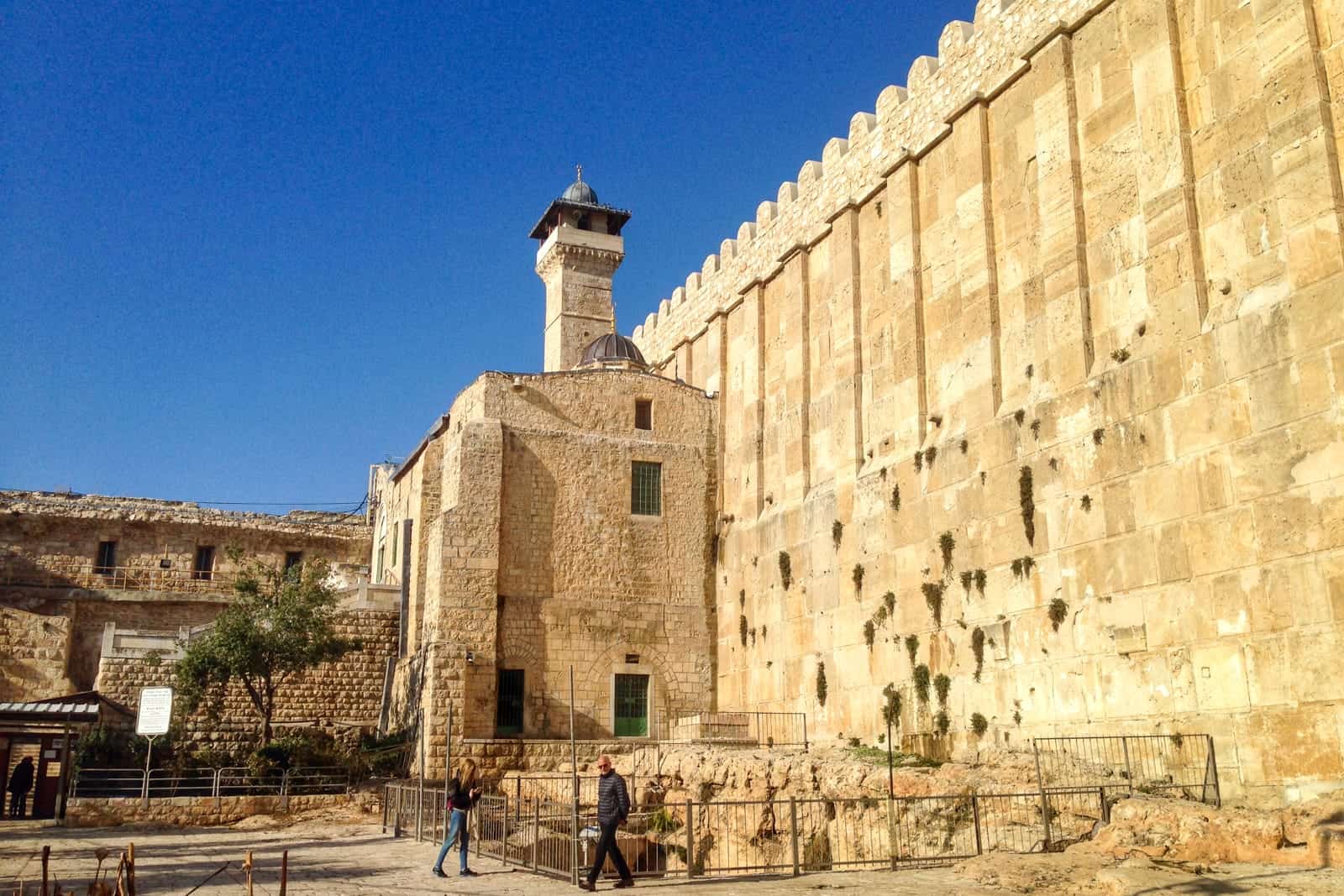
Tomb of the Patriarchs in Hebron, West Bank, Palestine
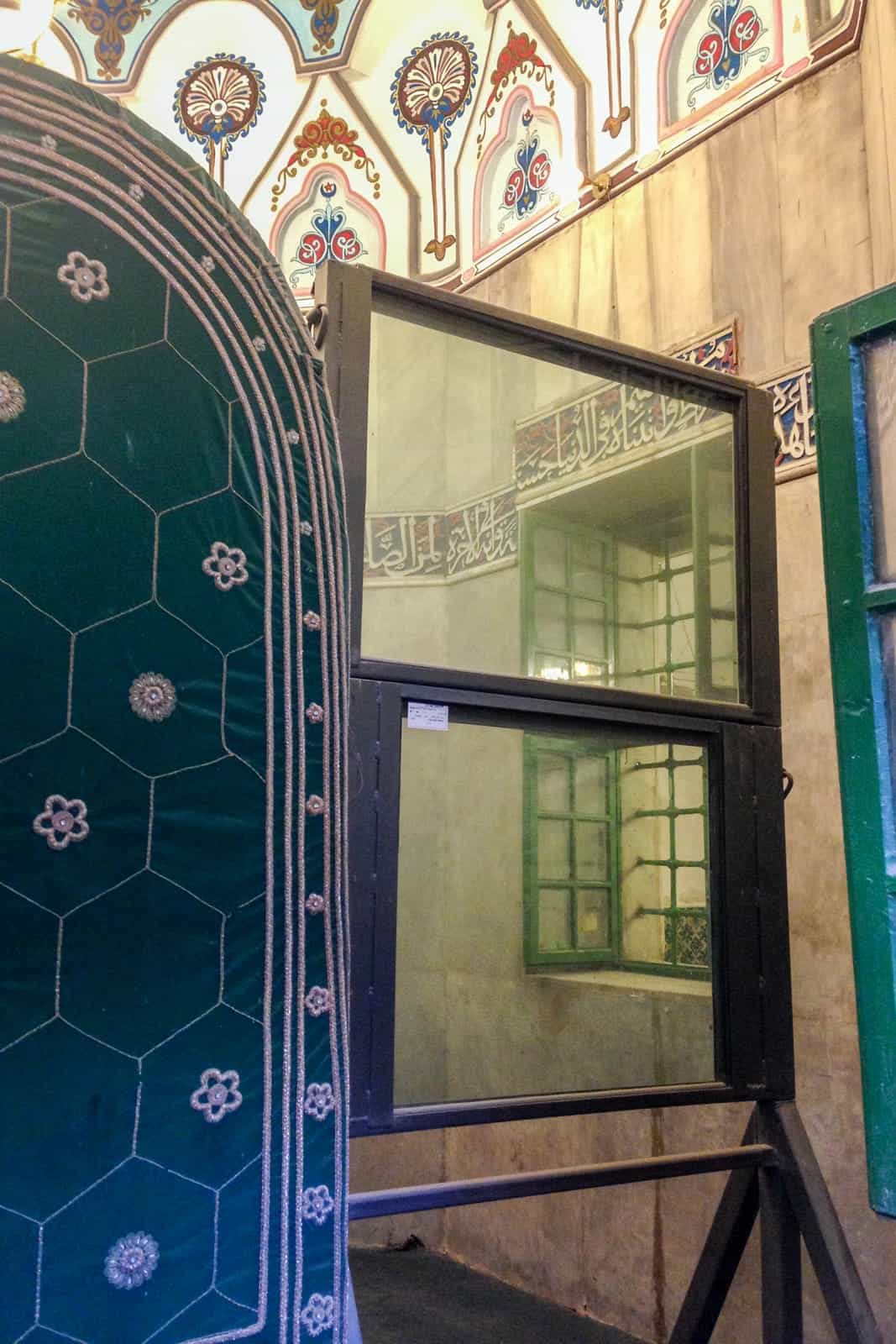
Tomb of Abraham with a bulletproof screen
Visiting a residential area, we learned about the reasoning of settlement here, which is basically about the ‘reclamation’ of land (with archaeological sites used as markers also) based on the heritage of forefathers that dates back to Biblical times, as is the reason used now for settlement in other parts of the West Bank).
A synagogue has even been rebuilt here on the original site (again, as history claims). You get to visit that also.
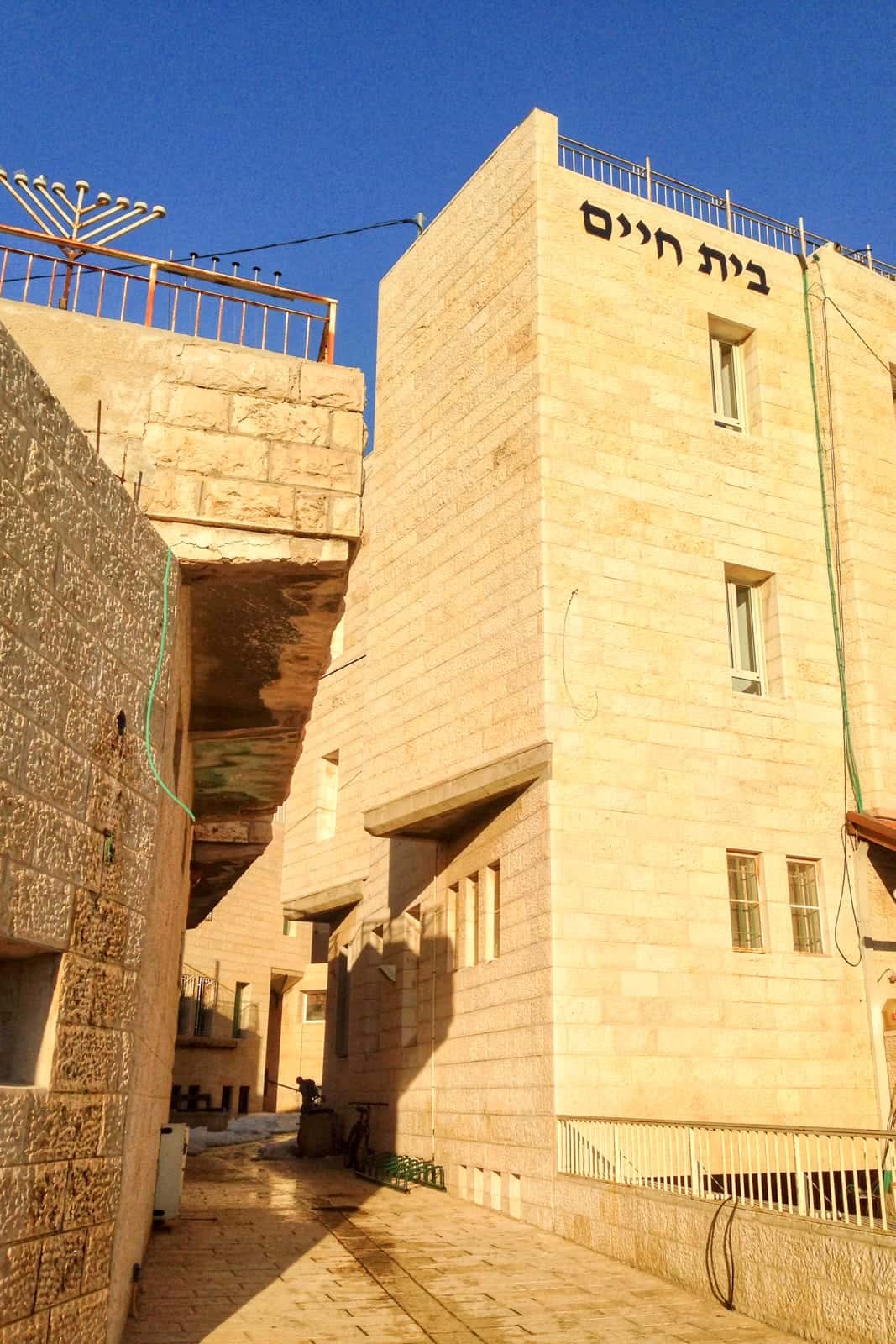
Jewish Synagogue in Hebron
To add to that, there’s also what we were told was “the Zionist response to a terror attack” which is to rebuild where an act of terror took place, and we saw many buildings that had been erected bearing plaques with the names of those who had died at the hand of suicide bombings.
Visiting the Jewish Museum, we were told about the 1929 Hebron massacre, with pictures depicting the slaughter of 67 Jews and the ransacking of homes and Synagogues by the people they once lived peacefully alongside – their Arab neighbours.
This terrible event is seen as an open wound and another reason given for the current Jewish presence here – it is seen as a form of resettlement after they fled the area because of it. However, as pointed out by Eliyahu, the museum is somewhat biased, with no mention of the 400 or more Jews who survived, thanks to their Arab neighbours who hid them and tried to protect them.
It’s fair to say that there’s been a continuous Jewish presence in Hebron throughout history (as with the Holy Land as a whole), but with Jewish people moving out after the massacre and returning decades later.
However, whether or not the Jewish people living here now have a direct ancestry line to those who lived here decades and centuries before, the issue is not with Jewish people as a whole (again, we have to be careful not to categorise ALL Jewish people in Israel), but with the strong nationalistic sentiments of this particular strand of Jewish thought – the ones who firmly believe they have a right to be here, despite rational thought and the idea of coexistence.
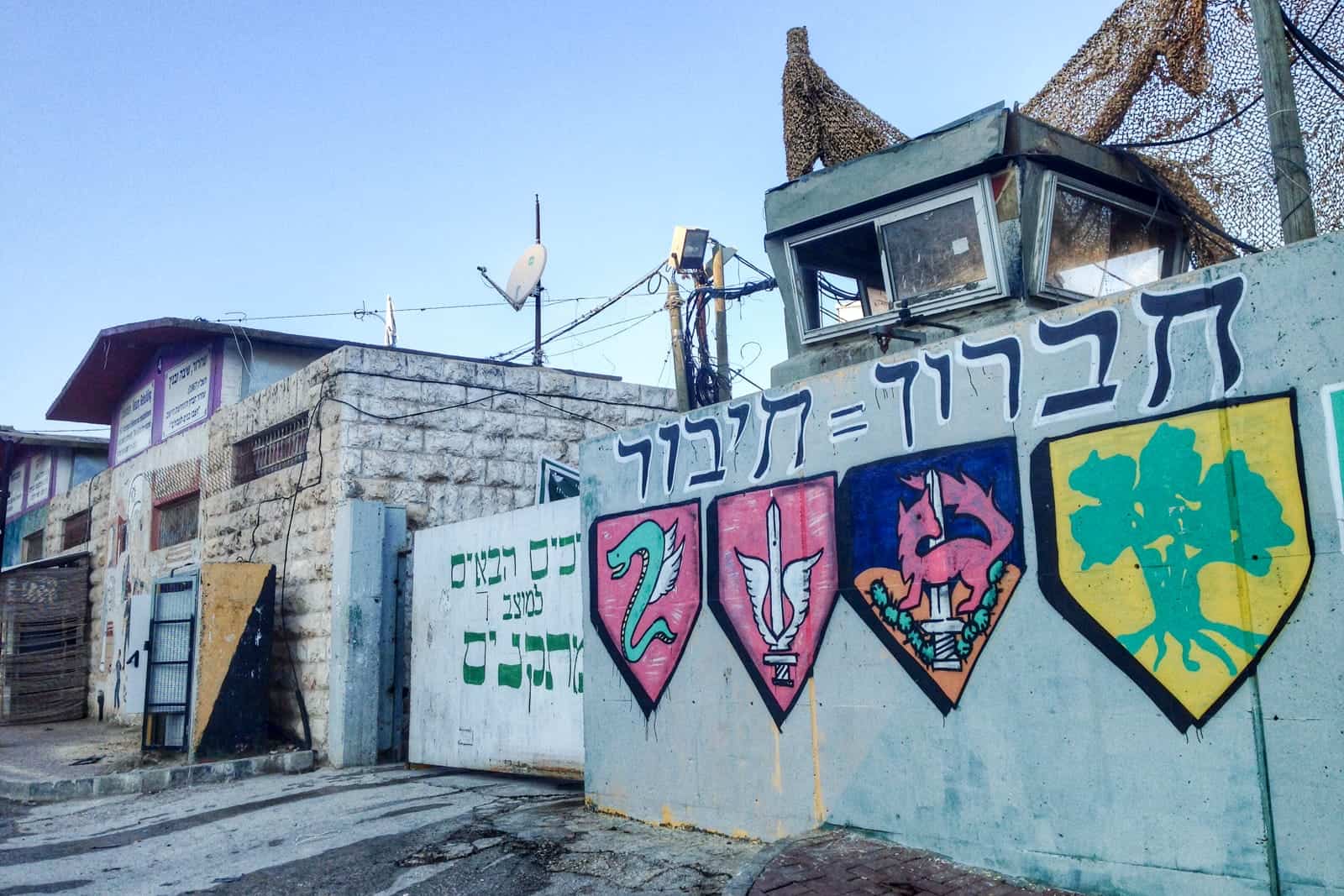
Israeli army building in Hebron, West Bank, Palestine
We ended our time up on a hill, on another Jewish settlement where a Jewish man had been murdered, resulting in the Israeli government granting permission for the settlers to build there. There are so many fractions of settlements in Hebron, each with its distinct reasons to build in a particular spot.
By that point, we had seen and heard enough. We understood both sides, but it didn’t mean we had the answers to everything. It just helped to give perspective on what is possibly the most complicated issue many of us had ever heard about.
But for a few minutes, we stood on that hill and looked out across the spectacular Hebron landscape – beautiful, peaceful, and laden with history. For a few minutes, It was almost as if nothing was happening there at all.
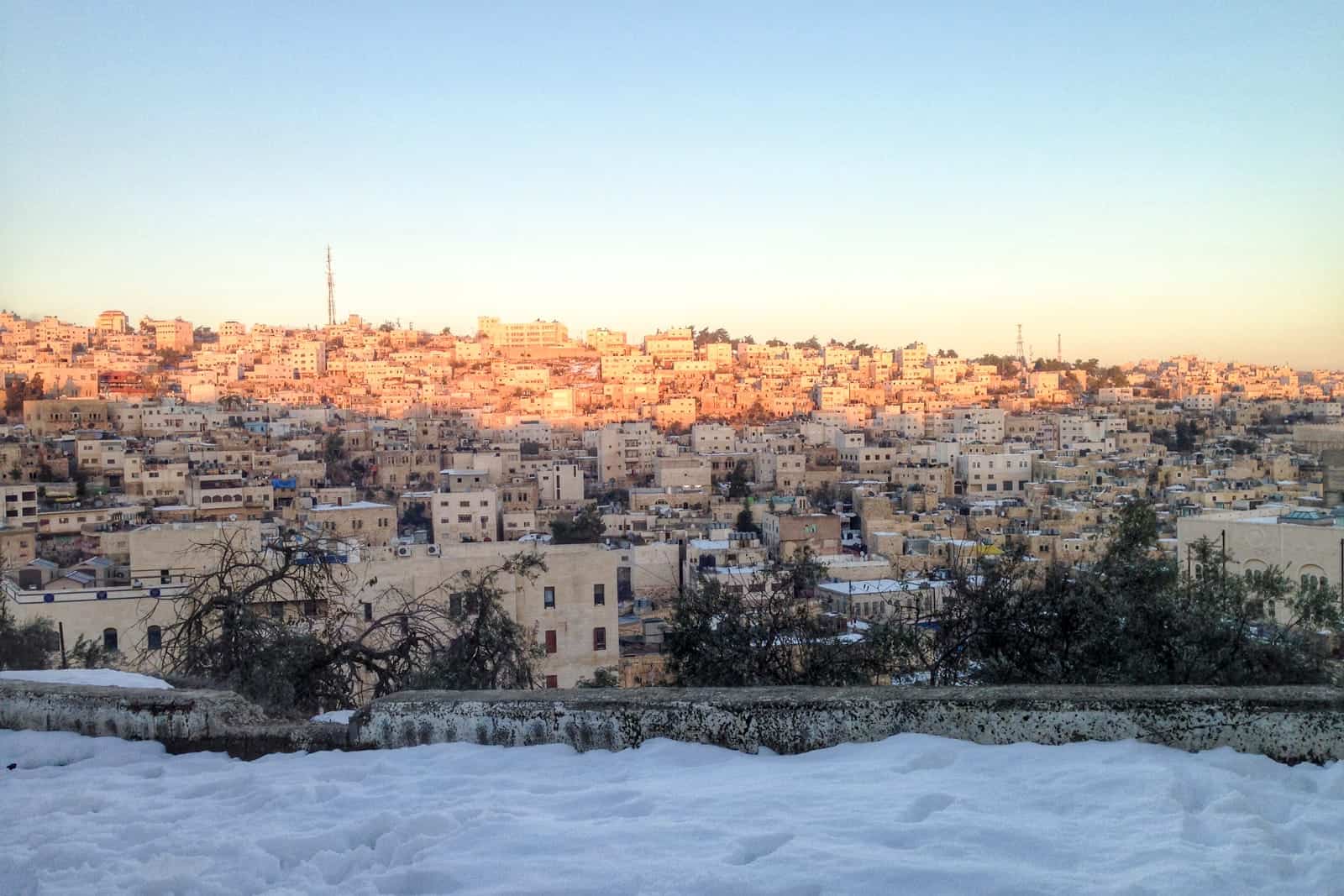
Jewish settlements in the West Bank, Palestine
After the long, emotional, but thoroughly insightful tour, many left to head back to Jerusalem. Five of us chose to cross into H1 again to meet Mohammad since we wanted to see the new Hebron – the modern side of the city away from the heart of the conflict and Israeli control – a city very much like the other cities in the West Bank, full of stores, restaurants, and other big businesses.
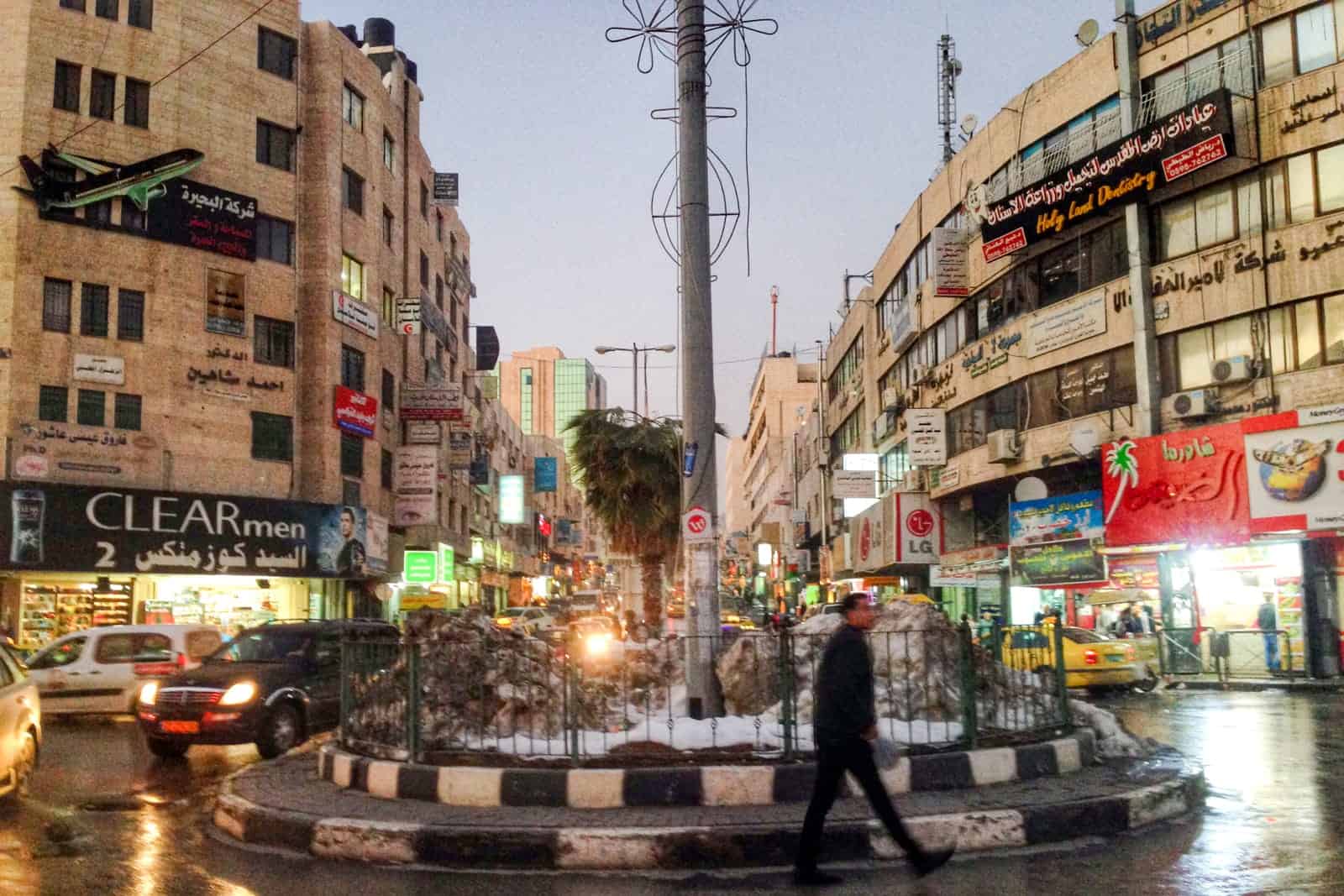
Hebron at night, in the West Bank
We tried local coffee and indulged in a hummus feast before getting on a bus to Bethlehem to cross the border back into Israel. None of us will forget that quality time with Mohammed, our new Palestinian friend, knowing that we would return to Jerusalem to do the same with our Israeli friends that same day.
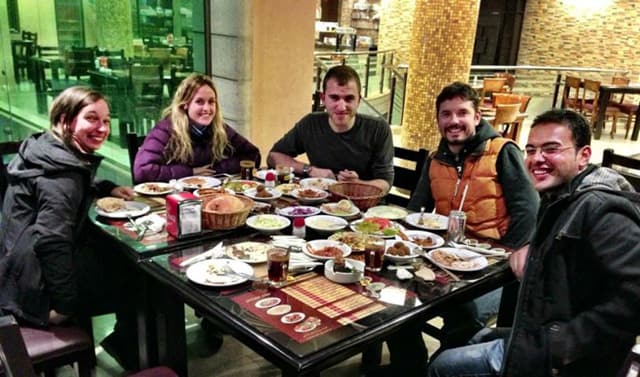
Friends in Hebron
Why You Should Take a Tour in Hebron
Maybe one day, we will all get to sit around the table together in both Hebron and Jerusalem without the need for divisions, checkpoints, and explanations. Maybe one day we can unravel the history of Israel and the history of Palestine and find some common ground.
That’s why these Israeli and Palestinian people are working together, after all – to prove that peaceful communication is possible.
Whatever your opinion, from what you’ve read, watched, or listened to, there’s nothing more important than seeing Hebron to formulate your own.
By actually being here, you become another part of the narrative, and you may well be surprised at how your own fervent, one-sided opinion becomes more balanced and informed.
Of course, there are many strands of narrative, including those of the army, civilians, left-wingers and right-wingers and everything else in between, but I will leave you with these wise words we were told.
“There’s room for all manner and strands of beliefs. Nationalism is poison. The only thing we should condemn is violence but continue to love the Holy Land.”
Book a Tour to Hebron and the West Bank Palestinian Territories
For all details and to book the Dual Narrative Tour in Hebron with one of my trip partners, Abraham Tours, can be found here.
- The full day tour costs 290 ILS = 69/ $78 / £61 and runs from 8 am until 7 pm.
- You will need your passport in order to cross through the checkpoints.
For an even more in-depth insight into the region consider a Palestinian Territories / West Bank tour that also covers Jericho, Bethlehem and Ramallah, as part of a day trip from Jerusalem. It’s fundamental to understand the region from your perspective, and why including a visit to the West Bank is essential in formulating a well-versed picture.

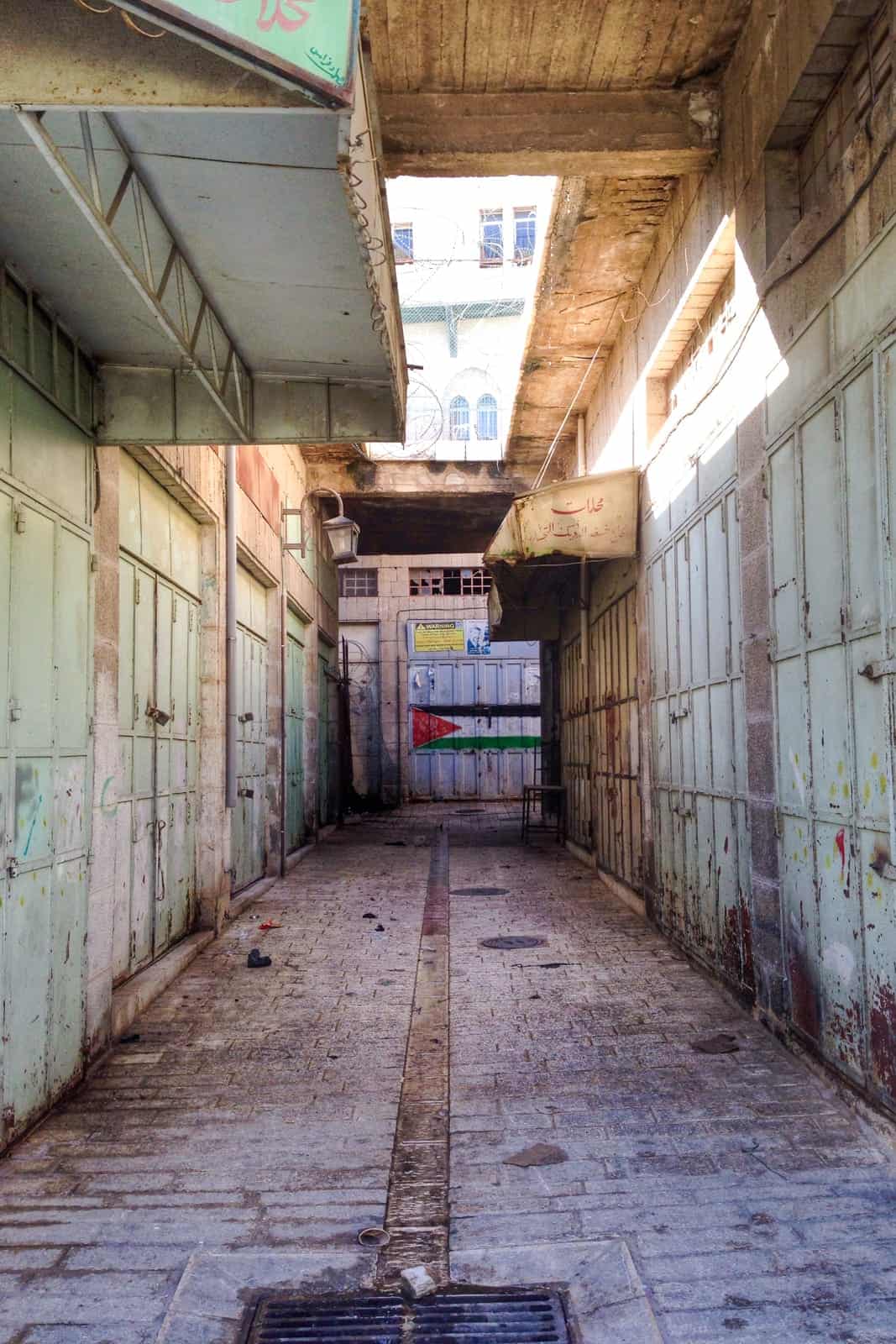
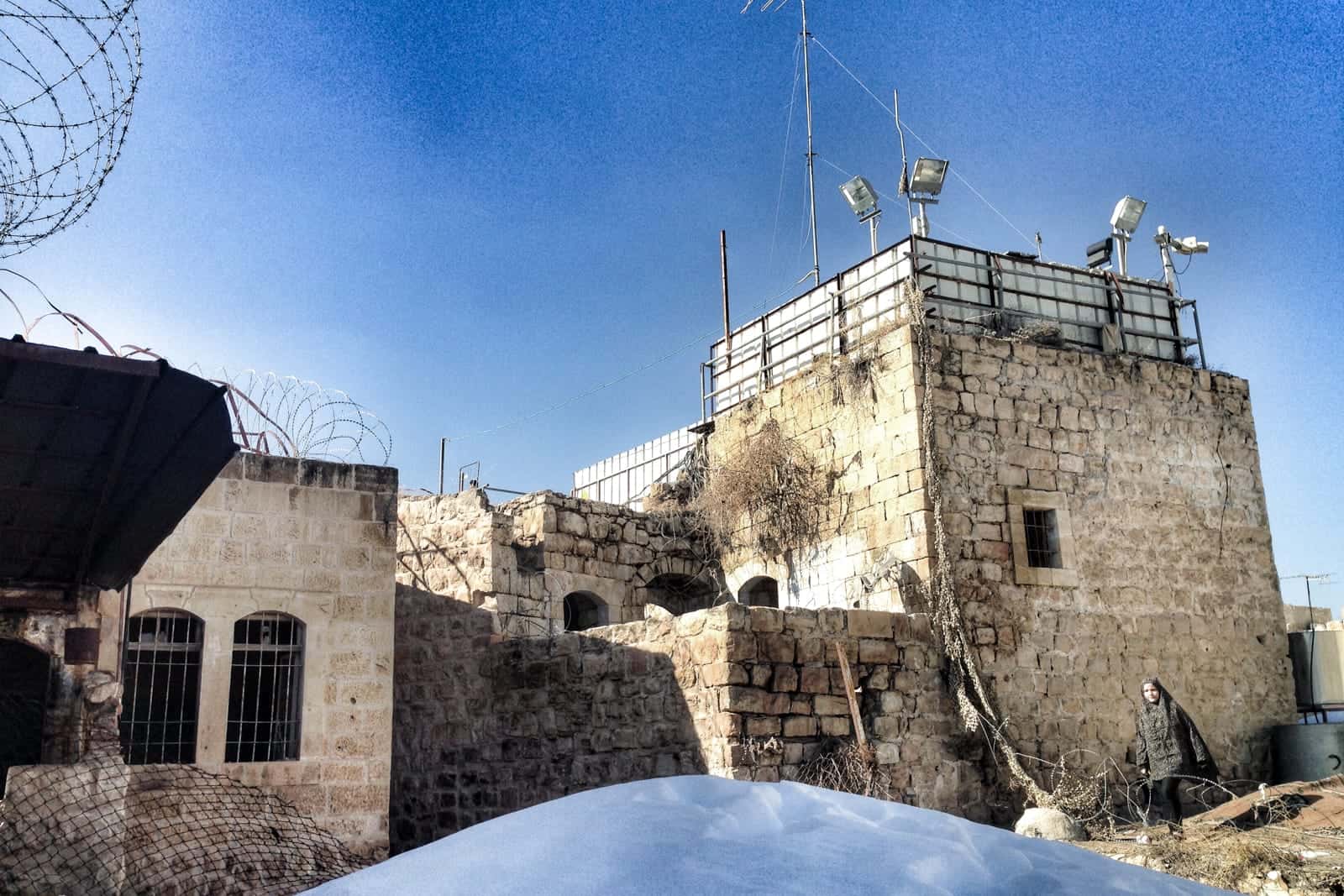
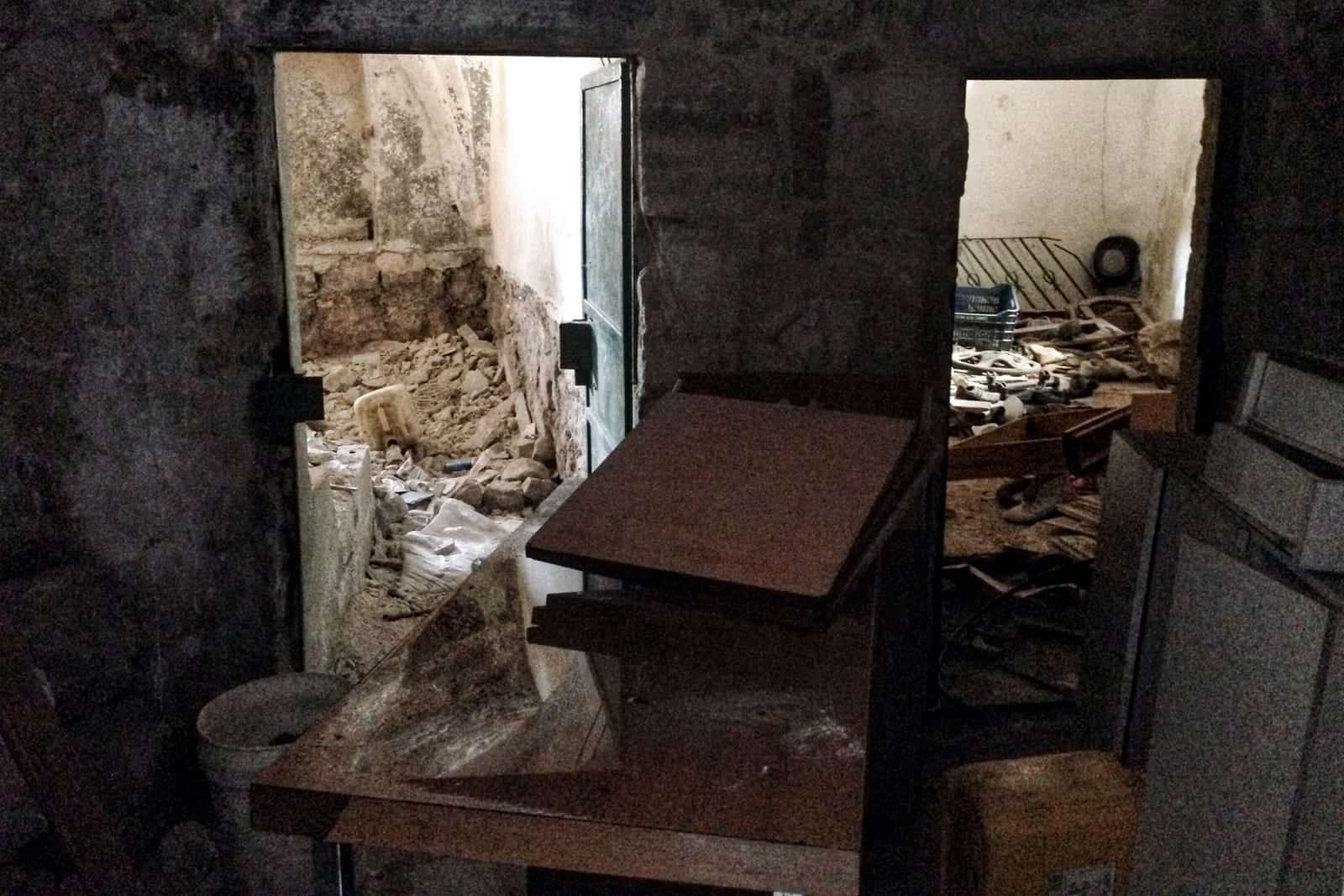
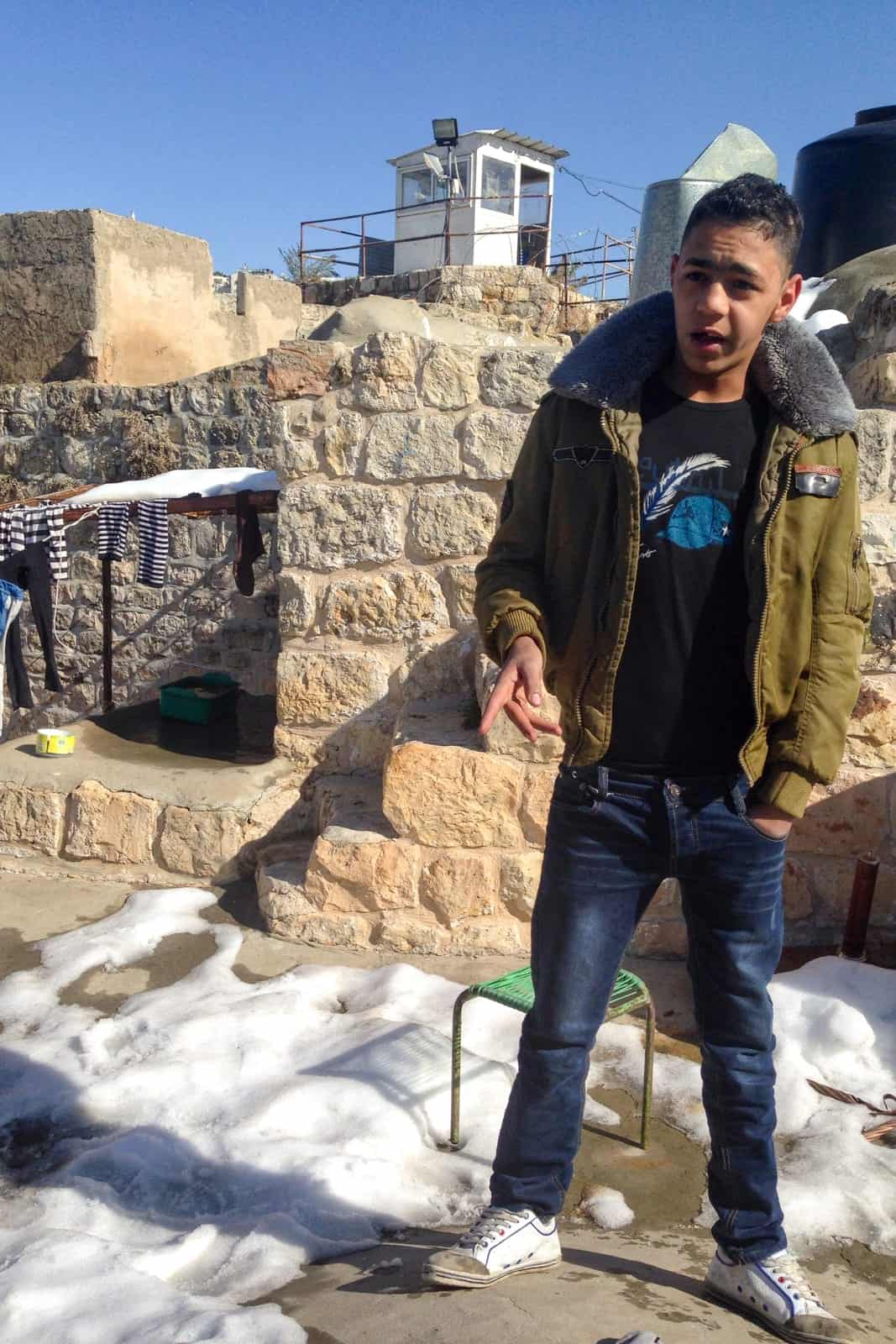
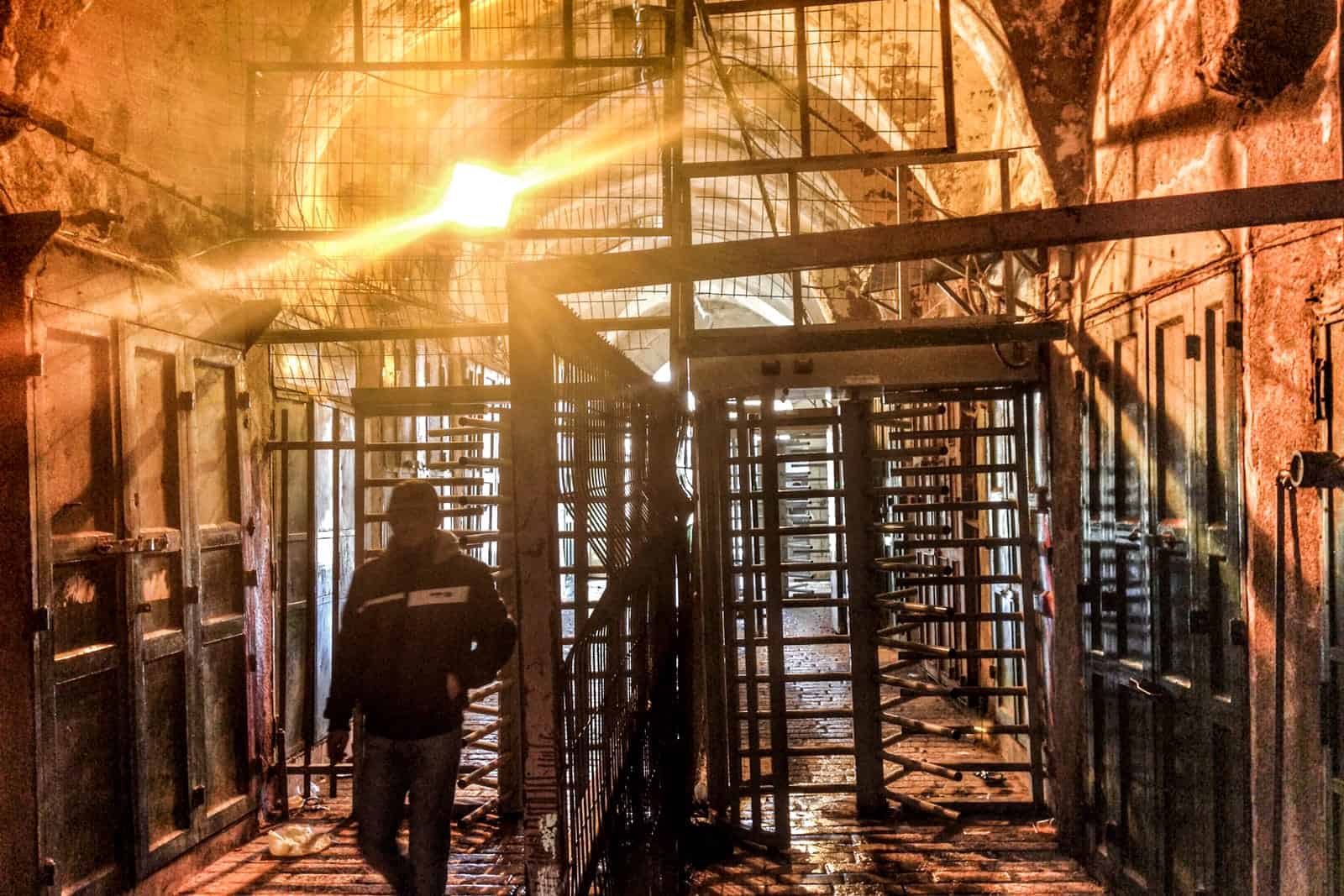
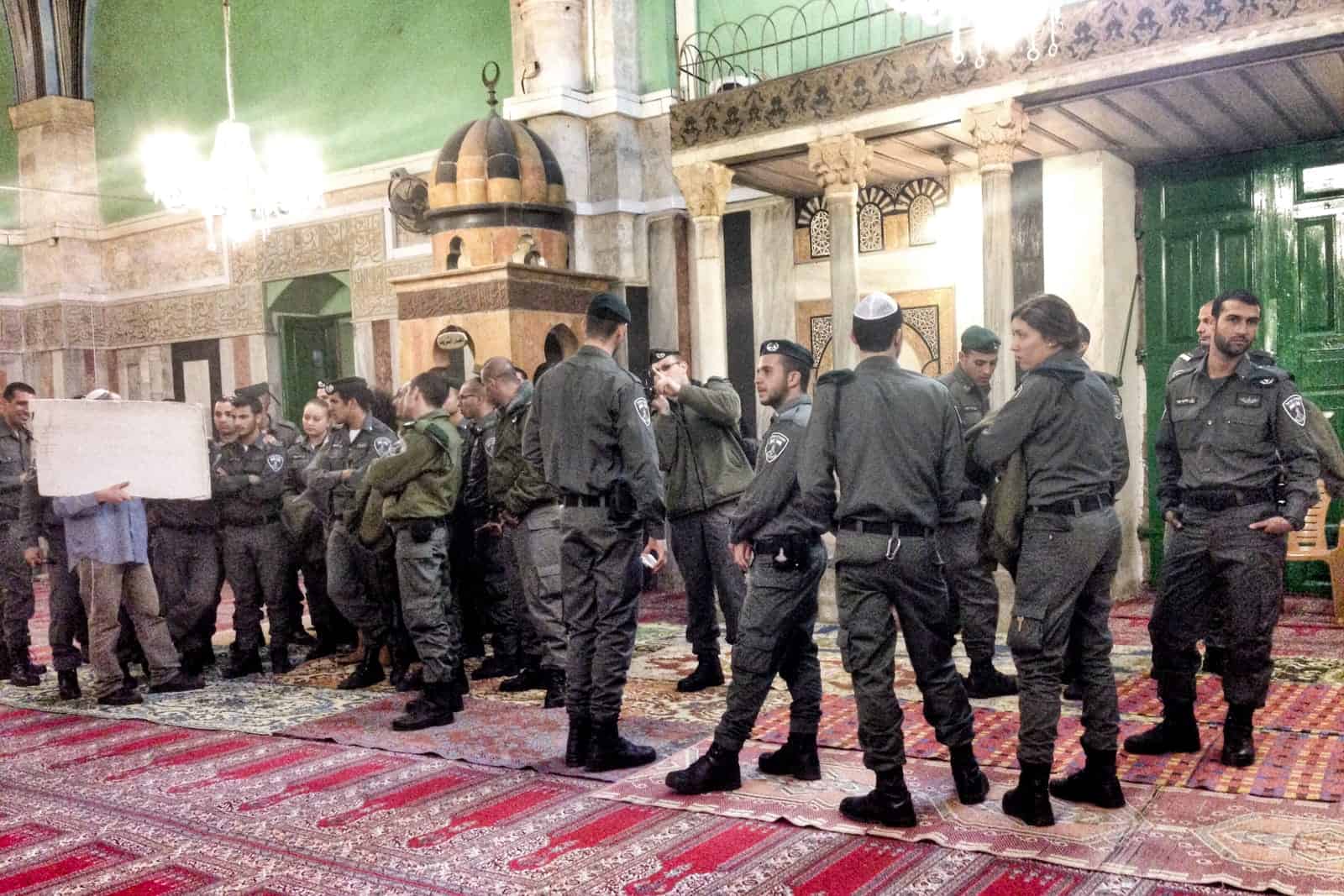
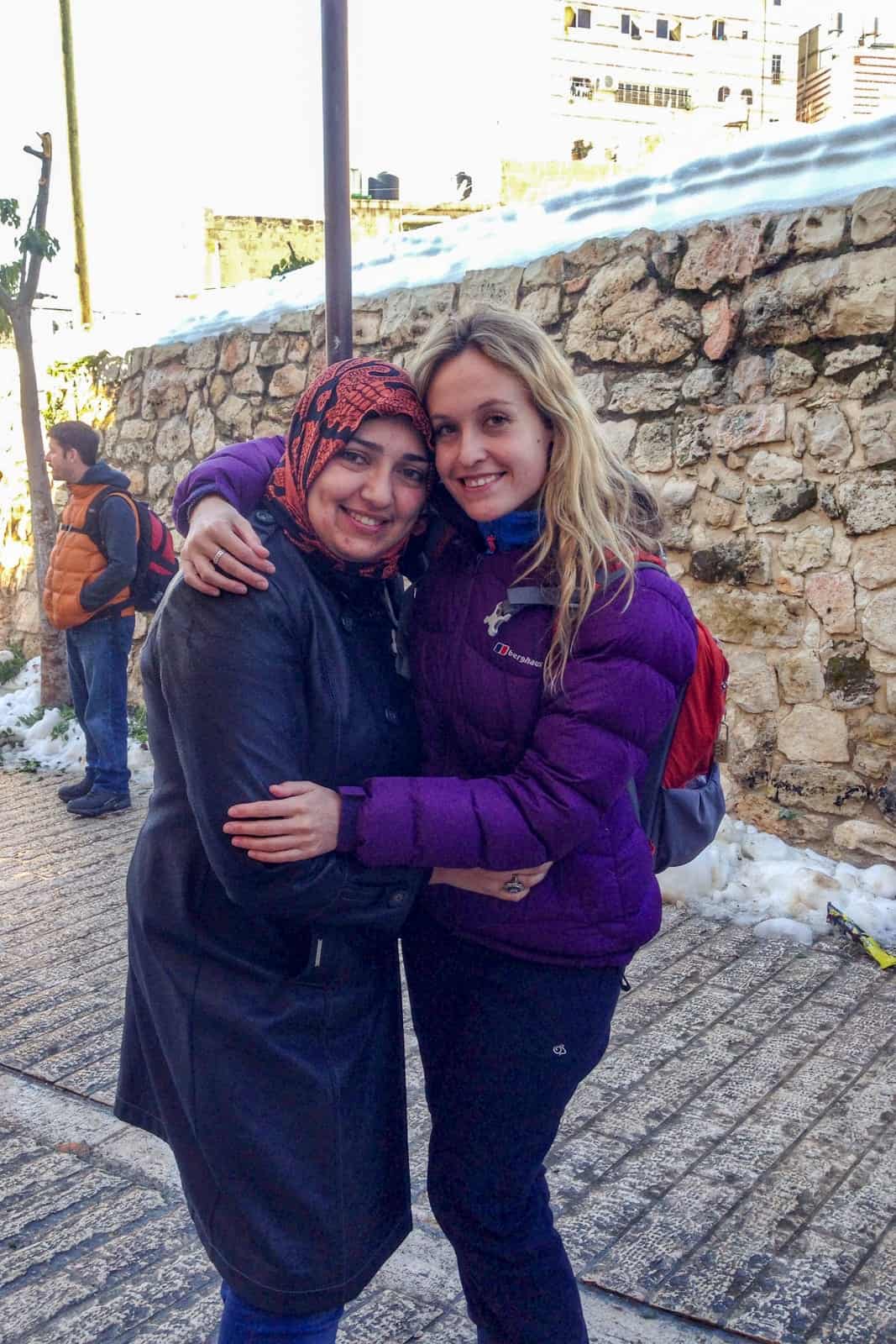
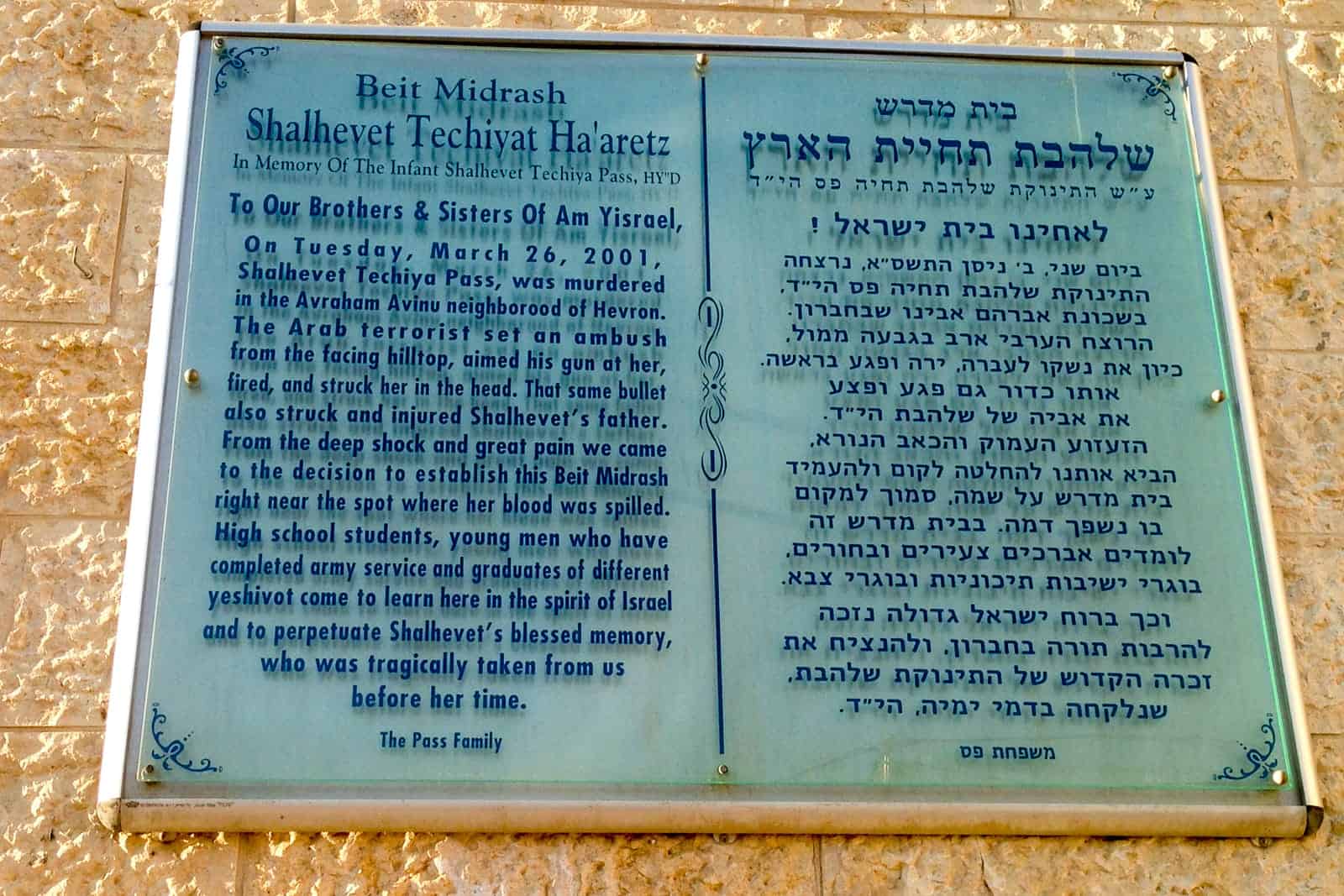
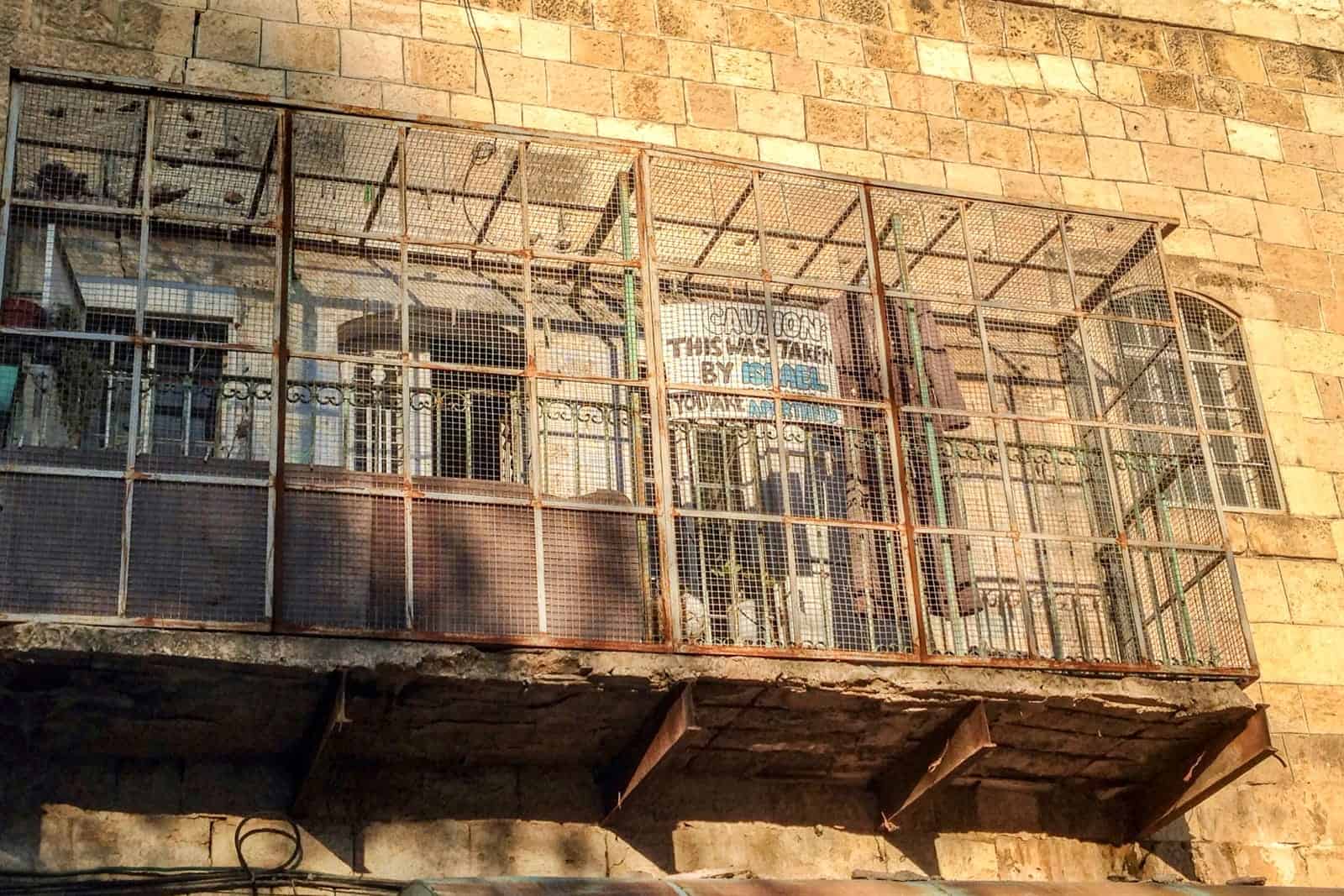
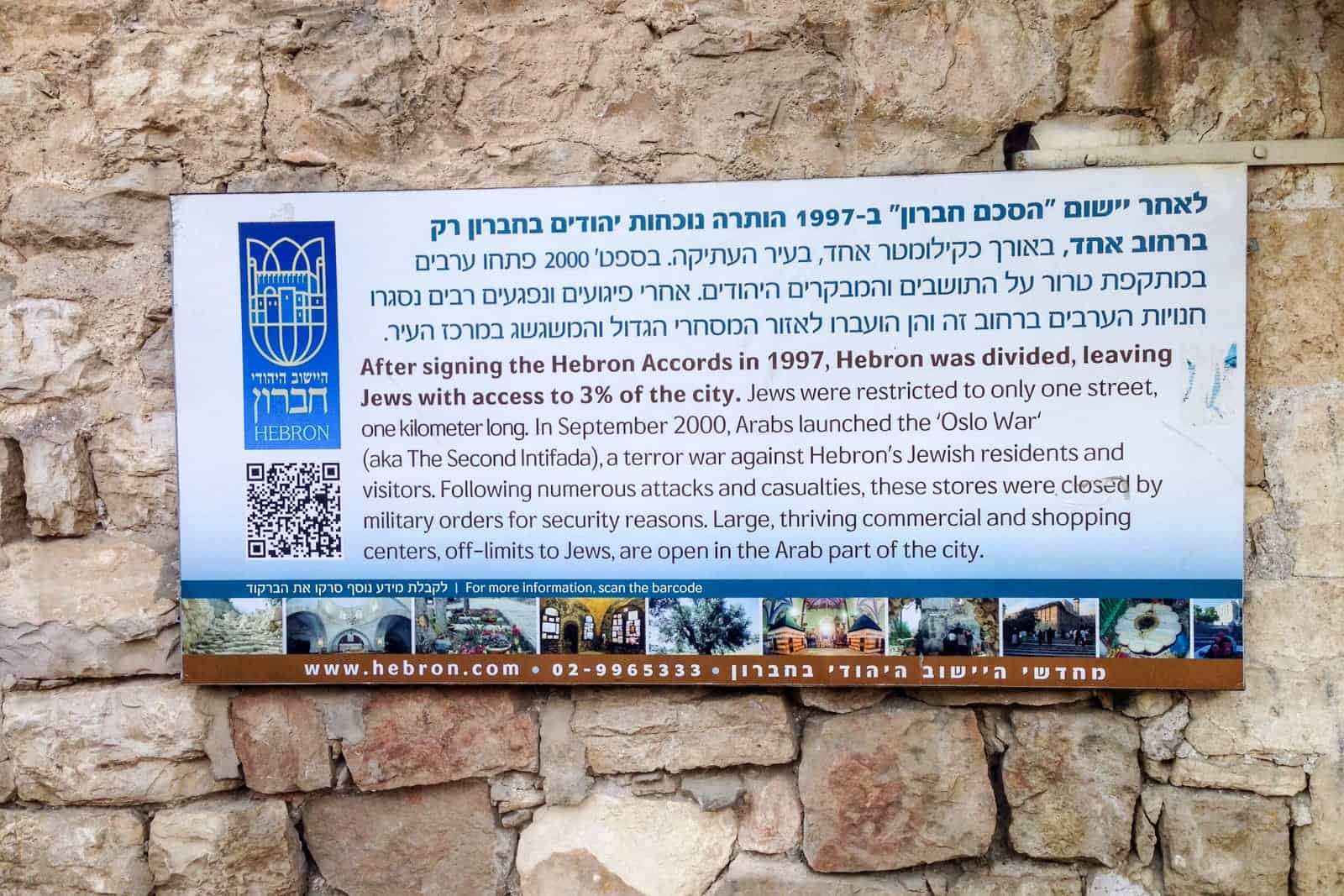
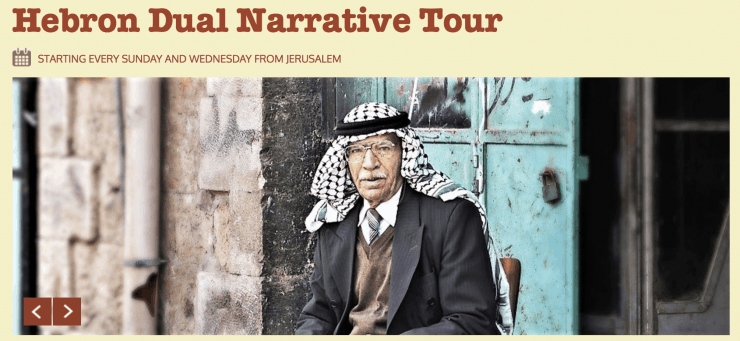

Katherine says
This is the first travel article about Israel and Palestine I’ve read that was actually GOOD. I want to express my appreciation for your writing. I sincerely agree with most of your views. Issues of identity become bigger problems when they are used to promote nationalistic agendas.
Jil says
Thank you for this interesting and insightful article. It is refreshing to see how you really tried to show both sides. Amazing that such a tour is offered in this area!
I just wanted to mention one thing: The reason the soldiers don’t take their shoes off at a mosque is that it’s a security issue. Putting such a shoe on and taking it off takes quite some time ( ask any soldier, I think it’s the same no matter which army) and in this time they would be vulnerable to an attack. As you say there’s a lot of tension there and they don’t want to risk anything.
Thank you also for the great pictures, it really makes a difference to see how the place looks instead of only hearing the name!
Natascha says
Thanks for this informative and detailed post. We think of hiking the Palestinian part of the Abrahams Way individually in autumn. Seems not many people travel in the West Bank, most seem to go on day trips.
Becki says
Many do, with limited time in Jerusalem. However, with there being hostels and guesthouses in various cities in the West Bank, many do travel through and see Bethlehem, Ramallah etc. The circuit to travel through is not as hard as people think and you will be very welcomed.
Kristen says
Wow – I add my vote to those who say best posts they have ever read. I’m choked up and amazed at the same time. What a great experience and hats off to those who organise the tours.
We had planned to visit Israel but after the recent issues there had taken it off our list as it didn’t feel right. But you’ve given me food for thought.
It also says a lot about your readers that all comments here have been measured, respectful and thoughtful.
Silvia says
This was such an interesting read! I recently couchsurfed with a guy living in the new part of Hebron, which definitely gave me more of the Palestinian side of things. He was really open-minded though and really just felt bad for everyone involved in the situation.
Yuri Vanetik says
I enjoyed your review of Hebron, having just visited it yesterday. It is truly complicated and highly emotional – the politics veiled in religions and superstitions. You are certainly correct in observing that much of the narrative is driven by actions of extreme groups and sensation driven media.
Flora the Explorer says
I’ve only recently been learning the full extent of the problems in Israel and Palestine, and this was a wonderful insight into how things are much more complicated that just being black and white. While I’m deeply interested in the situation, I’ve felt like I can’t justify visiting Israel because of my support for Palestinians, but maybe it’s worth visiting both places and making my own summations afterward.
Becki says
Whatever you thoughts are now, they will be more confused when you arrive. You’ll leave with more questions, yet hear more perceptions than you thought possible. Don’t let your pre-judgment/thoughts put you off visiting. Best to go there and see the complex situation for yourself… and realise that there is a difference between the ordinary people of Israel and the nationalists/settlers/government and the ordinary people of Palestine and the nationalists/government.
Sharif Fares says
I am a Palestinian who is actually living in Hebron. I want to say that I enjoyed reading your post very much. I loved the fact that you had the courage to visit while the news tell you not to; the natural of the news emphasizes on bad stories and sometimes on biased reporting instead of just telling there are everyday people and good human beings everywhere. Everyday people are what making life interesting and enjoyable.
Ben says
This is truly an incredible post. You are extremely articulate and seemed to get a lot out of your trip. I definitely want to visit now so I can understand this issue further!
Hosse says
Wow this is so interesting and complicated. I will be volunteering in Hebron this November. It really gave me a good insight into what the city is like and its very difficult conflict between the Palestinians and Israelis. Thanks for sharing this great piece!
Laura says
I really like the idea of the dual narrative tour as a great start to seeing both sides of the story and forming an opinion. It’s an interesting concept that I can’t imagine you get in other parts of the world. I bet it was so emotionally exhausting though. Thanks for sharing!
Gloria Grove says
Your post was one of the best I have ever read…..more people need to learn about the West Bank, preferably by traveling there and observing for themselves.
Adam says
Becki – great to read your write-up of the Hebron tour. I’m a big fan of this tour and highly recommend it. I also suggest tours with Breaking the Silence which go into some other areas of Hebron – hope you can join one of their tours in the future. I think you’ll find it equally interesting!
Brad Bernard says
Great article, Becki. There are obviously heated emotions on all sides, but I like how you’ve eloquently captured the human element in this challenging situation. I admire you for taking the courage to peel back the layers and look deeper.
Becki says
Thank you. It was hard, and I have only scratched the surface of this topic.
Corinne says
Fascinating post…just like the history and the continued conflicts. I think you did both sides justice and I wish I’d known about these dual led tours when I was in Israel last April. Love your photos!
Audrey says
Thanks for sharing your experiences in Hebron. In reading this I realize how I can only fathom such a tiny percentage of the depth and history of the issues in this area. It also makes one realize that most of the coverage we see on the news just skims the surface of the real issues.
We are looking at traveling to Israel and Palestine this year. Could you share the organization/company you went with for the tour of the Palestinian side Hebron (H1)?
Becki says
It really is a tiny percentage but a great insight away from our media bias.
The link to Abraham Tours (who run this Dual Narrative tour that starts in Jerusalem) is in the article 🙂
Yanira Rivas says
Excellent post! Captures the conflict in such a balanced and honest way. Hebron is a must visit for those traveling to the region. It indeed teaches you so many lessons in just a few hours. Great post!
Melanie Murrish says
I’ve learnt more about the conflict in this one post, than I did in a year in history class!
Neil says
Really good post Becki, I was in Israel last summer and realised how much I didn’t know. Can’t imagine travel gets much more complicated than that so really well done, it’s a great piece.
Ed Rex says
Literally one of the best posts I’ve read in a long time. You’ve really captured all perspectives on such a controversial subject perfectly.
Going back across the border at Bethlehem, did you get any trouble for having travelled in Palestine?
Becki says
It’s fine going in and out while you are there. It’s just not something you should mention at the airport, at all.
Maitha says
Excellent post Becki, a topic so many have written about in the past but this is by far one of the most balanced and insightful that I’ve read.
Must have been a fascinating trip and like you say, you can only hope that one day life will be better for all the families on both sides.
Amanda says
REALLY interesting read, Becki. This tour sounds very sobering, but also really great. It’s tough to truly get both perspectives when it comes to issues like this, but it sounds like you really did here. Thanks for writing about it.